-
Posts
1,397 -
Joined
-
Last visited
Content Type
Profiles
Forums
Gallery
Events
Posts posted by archjofo
-
-
Equipment of the mizzen yard - Slings and Quarterblock / Suspentes et poulie d'ecoute
The mizzen yard of the La Créole had no jackstay and only a quarter block for deflecting the sheets in the middle of the yard. This block was therefore designed as a double block, as can be seen in the following detailed photo of the Paris model.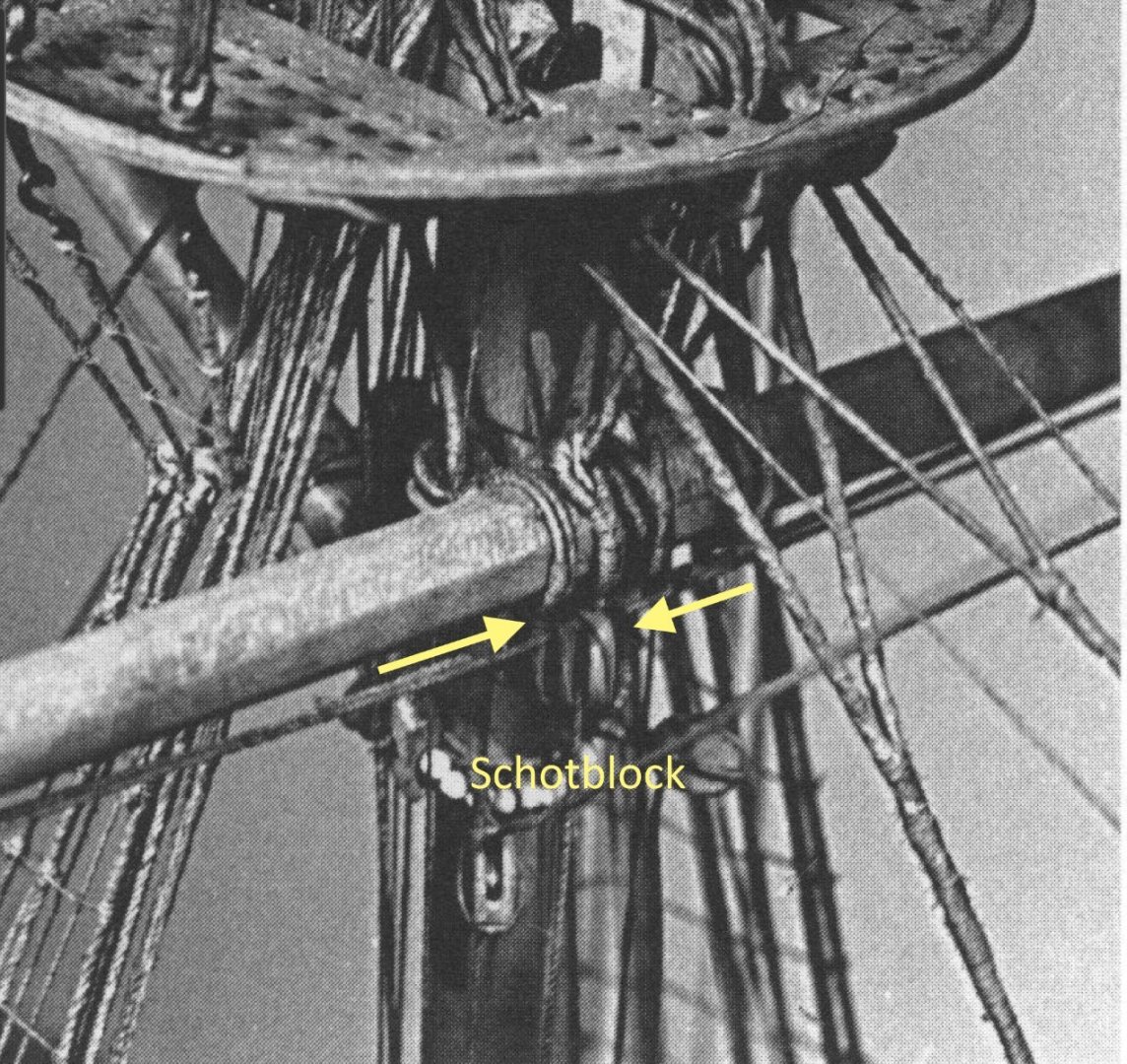
Source: La Créole monograph by J. Boudriot, page 168Based on these double blocks with a length of 5.6 mm in model size, I would like to explain my method of block production in more detail.
I scale the drawing of a double block from the Atlas du génie maritime to the required size and glue the printout to a strip of pear wood with the appropriate dimensions. Since I use separate discs for this block size, the disc gates are milled in the next step. In this case with a width of 0.6 mm.
After shaping with an emery file, the grooves for the strops are made with a round file. The fine sanding is done with a fine steel wool and the final finish is done with a ball matting.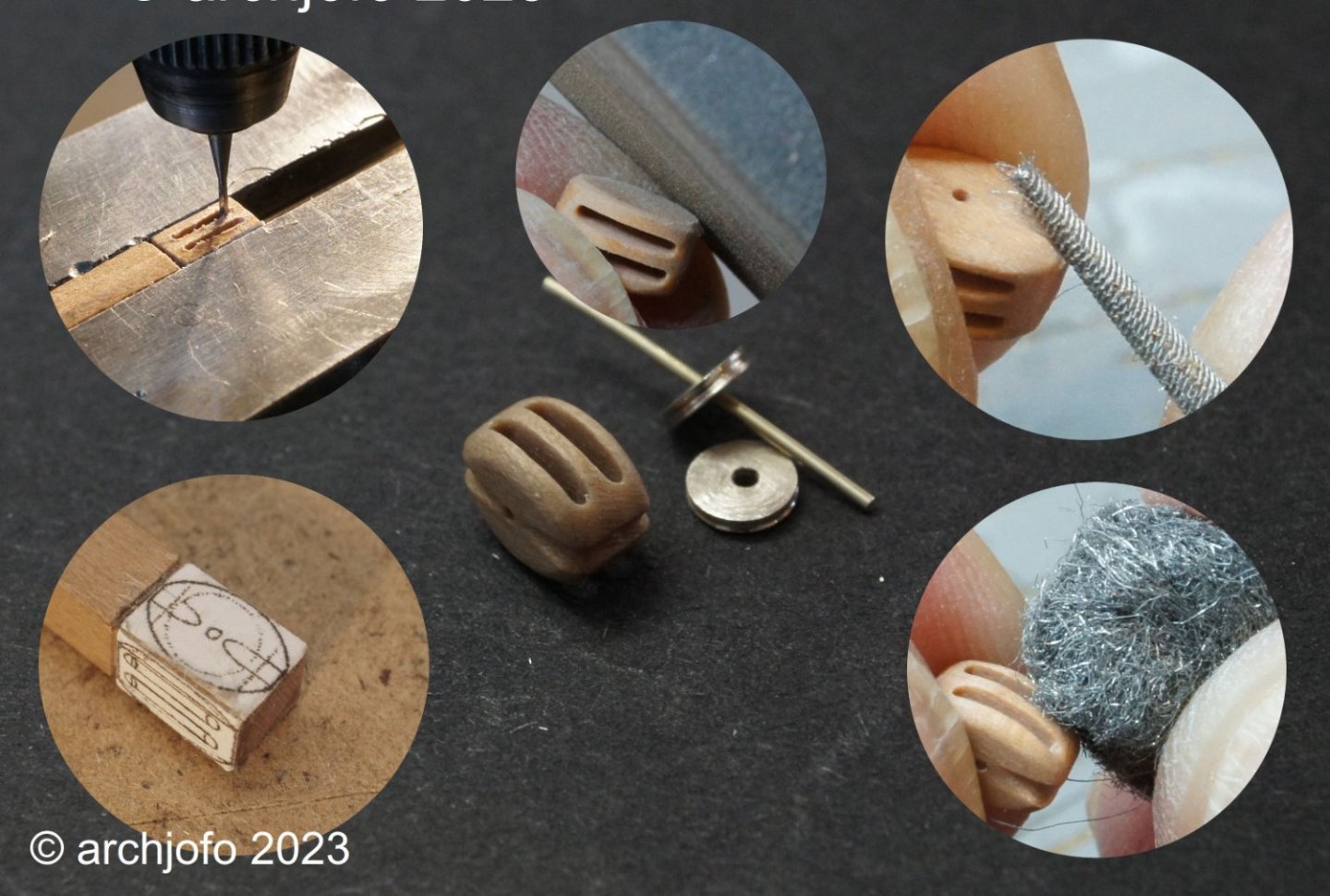
As can be seen in the next picture, I have meanwhile attached the fully served slings and in between the double block for the mizzen topsail sheets using rose lashings.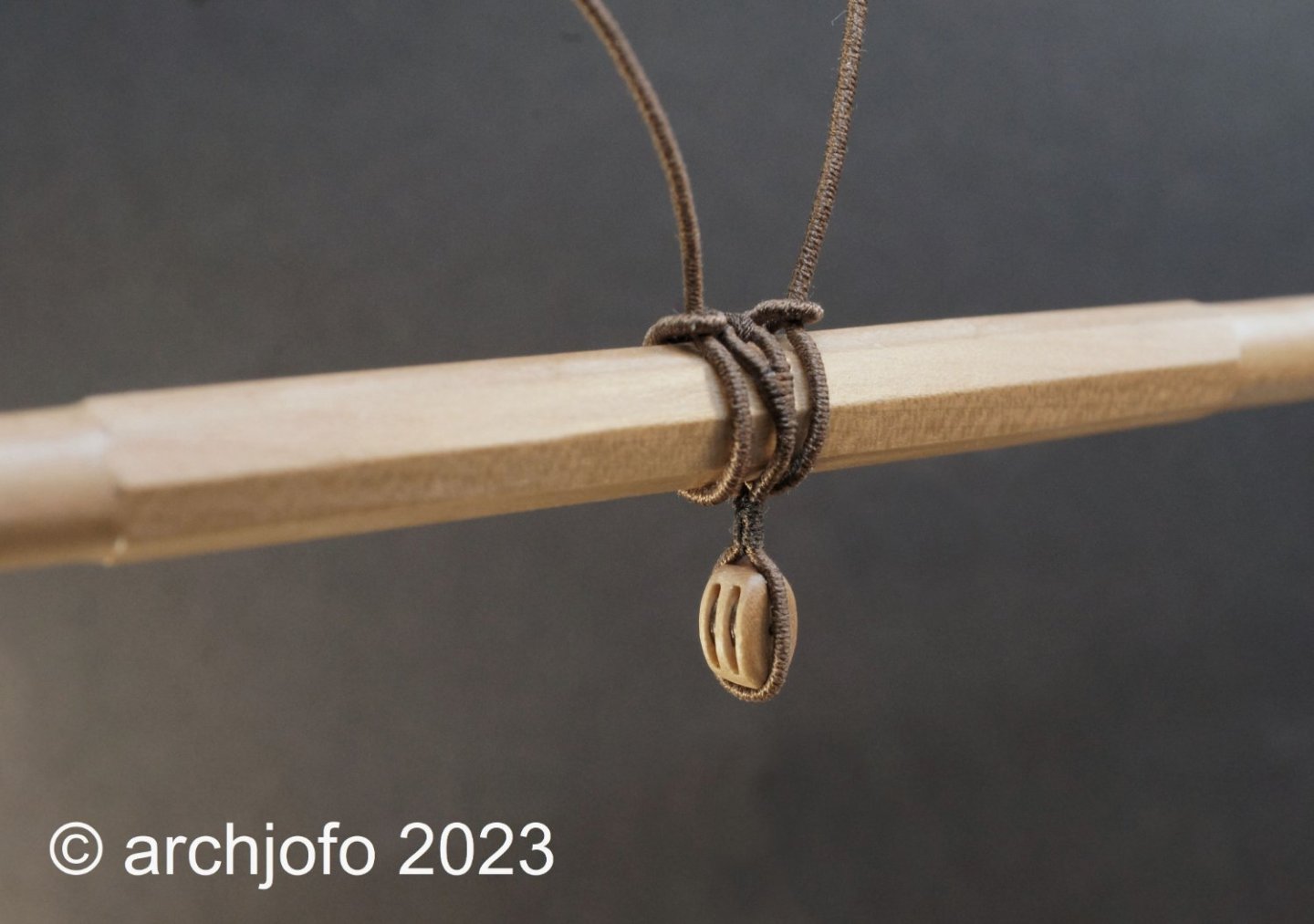
The next step will be the production of the truss pendants.
Sequel follows … -
Completion: Equipment of the fore yard
With the production and arrangement of the blocks for the clewlines, sheets and tacks, the fore yard is fully equipped and is set aside until assembly on the model.
At the end of this work on the fore yard, here are a few more pictures:The last of the lower yards that still needs to be equipped is the mizzen yard.
Sequel follows … -
Thank you for your praise. Nice to hear.
Continued: Equipment of the fore yard - topsail sheets, lifts and studding sail booms
In the meantime, the topsail sheets, the lifts and the studding sail booms were attached to the fore yard for my little French girl.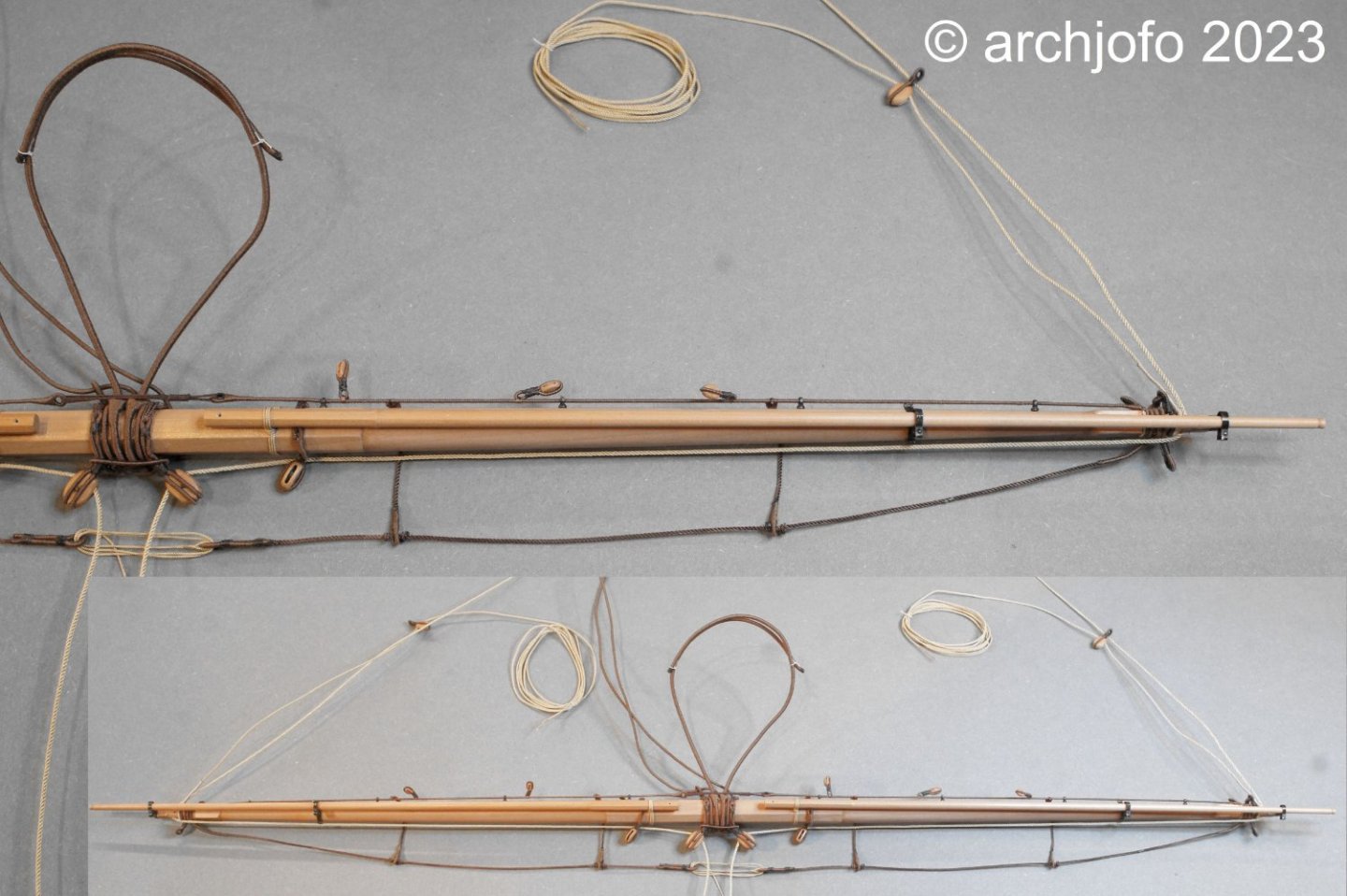 I almost forgot an important detail to complete the equipment of the fore yard, namely the arrangement of the blocks for the clewlines, the sheets and the tacks.
I almost forgot an important detail to complete the equipment of the fore yard, namely the arrangement of the blocks for the clewlines, the sheets and the tacks.
I'll do that again and report back soon.So see you soon...
-
Hello fellow colleagues,
I am really happy about this feedback. Thanks a lot for this, also for the many LIKES.Jerry,
Thanks for the hint.
OK, my mistake, I should have attached the lifts.So don't worry, once the lifts are in place, they will of course prevent the strop for the brace block from being pulled out over the sheet sheave.
I've done that in the meantime, as you can see in the picture.The rope for the sheet has also been drawn in.
-
Continuation: Equipment of the fore yard - Bream blocks - Poulie de bras
In the context of the production of the brace blocks with stroops for the fore yard, I would like to go into more detail here as well.
The length of these blocks is 24 cm in the original, which corresponds to 5 mm in 1:48 scale. With this block size I do not use extra sheaves, but work them out of the wood.
The served strops for the blocks of the fore braces on my corvette were connected by thimbles, which was commonly called "dog and bitch" connection (see drawing).Source: The Anatomy of Nelson's Ships - Longridge, C. Nepean - Spritsail yard of HMS Victory
The following picture shows a brace block with the prepared strops and the thimbles already connected. The connections of the strops can be seen by the dark color of the super glue. These areas will be covered later by the lashing and will then no longer be visible.
The manikin is to show the scale of the block with the strops.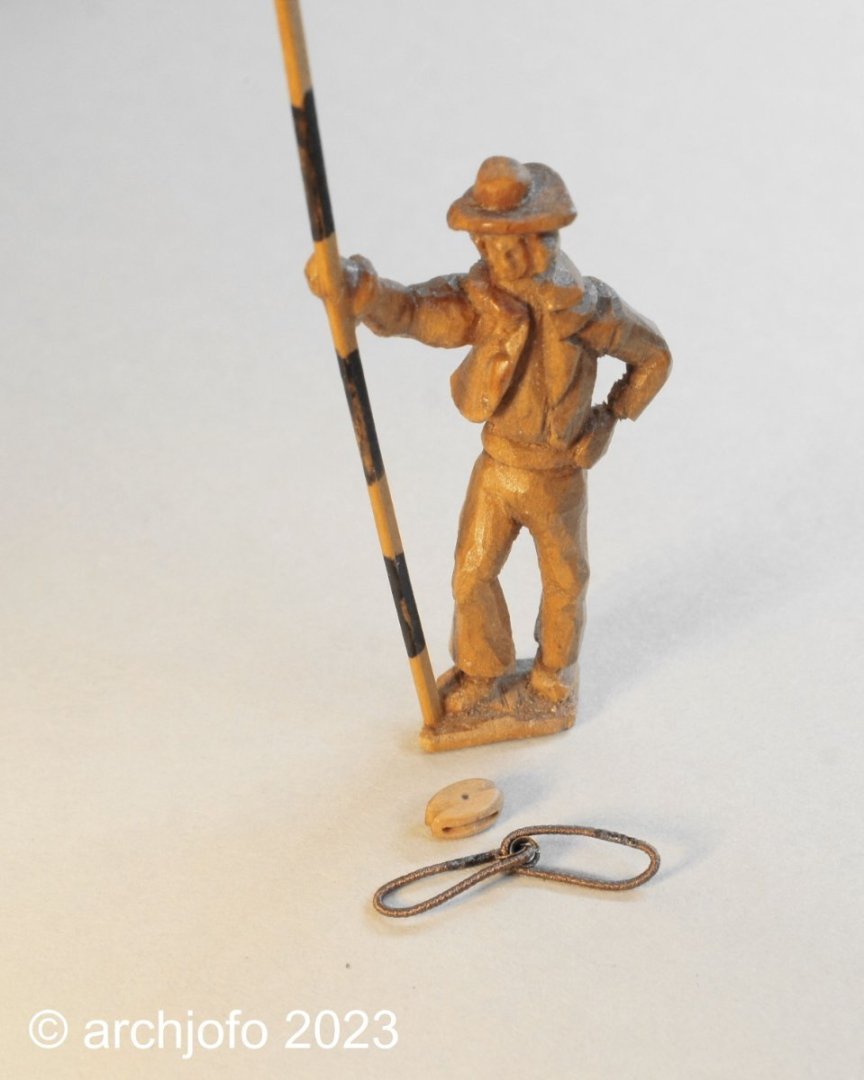
The next picture shows how the lashing is applied around the gluing area.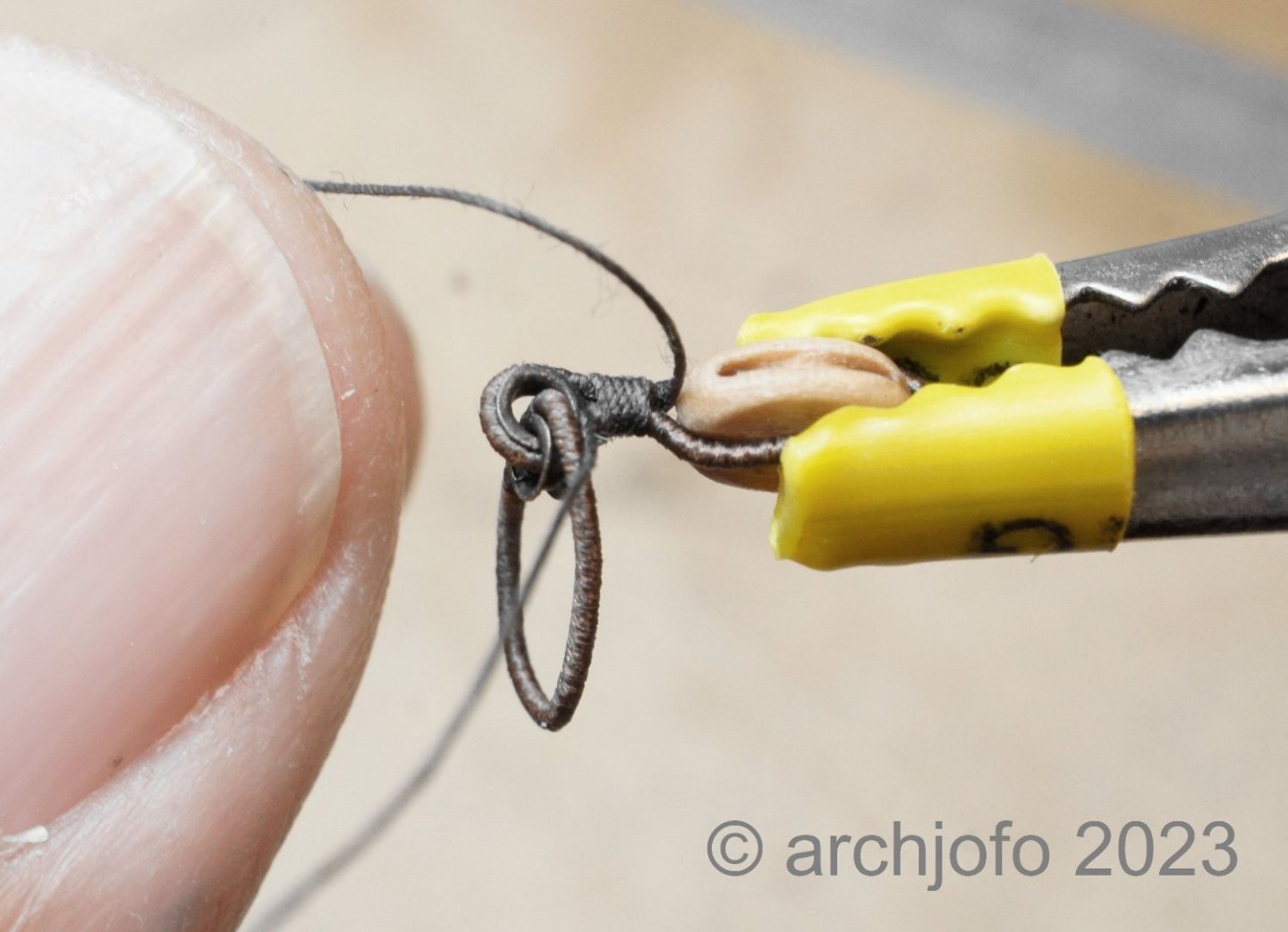
Here you can see the finished rigging element.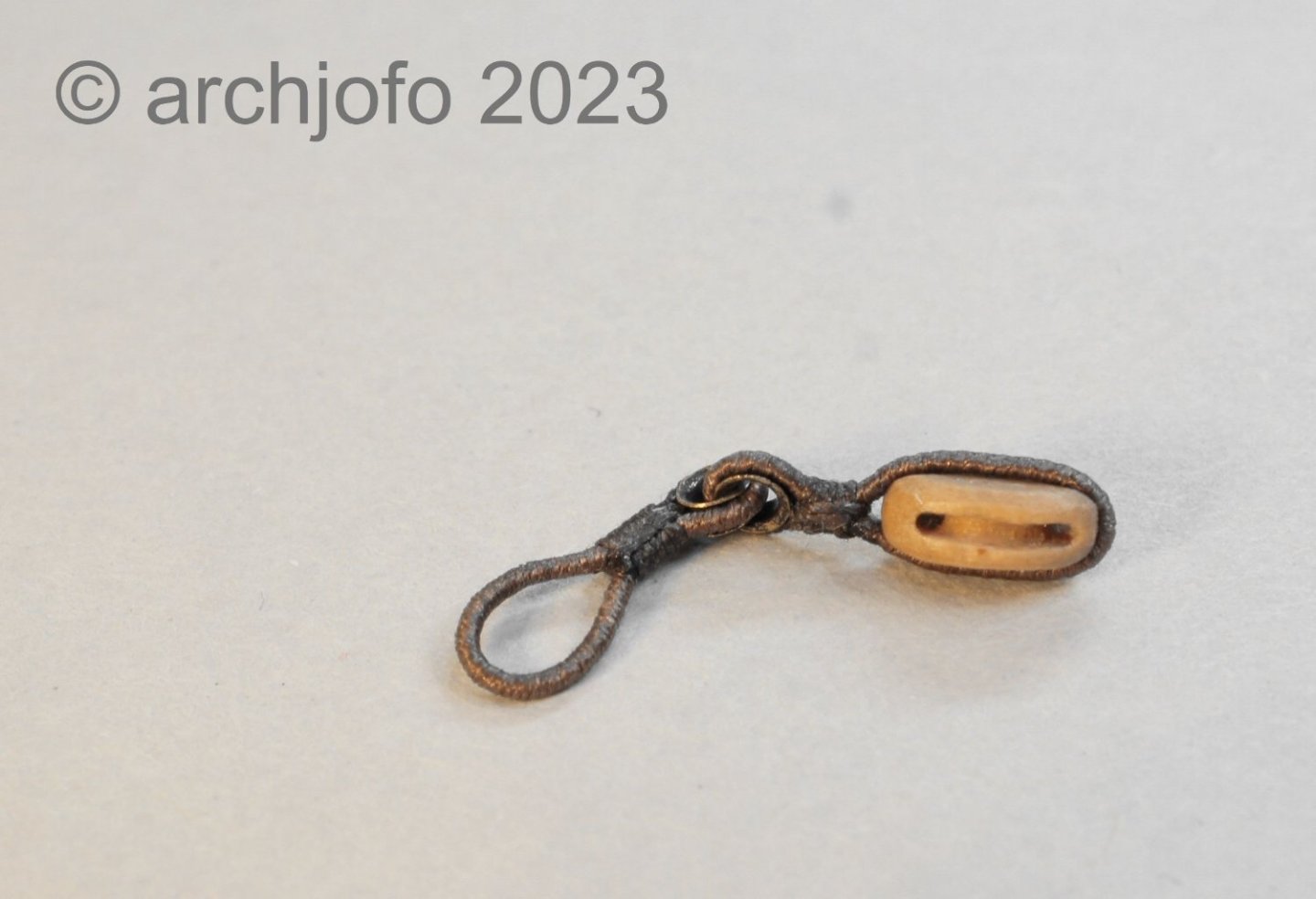
The next picture shows the port side yardarm of the fore yard.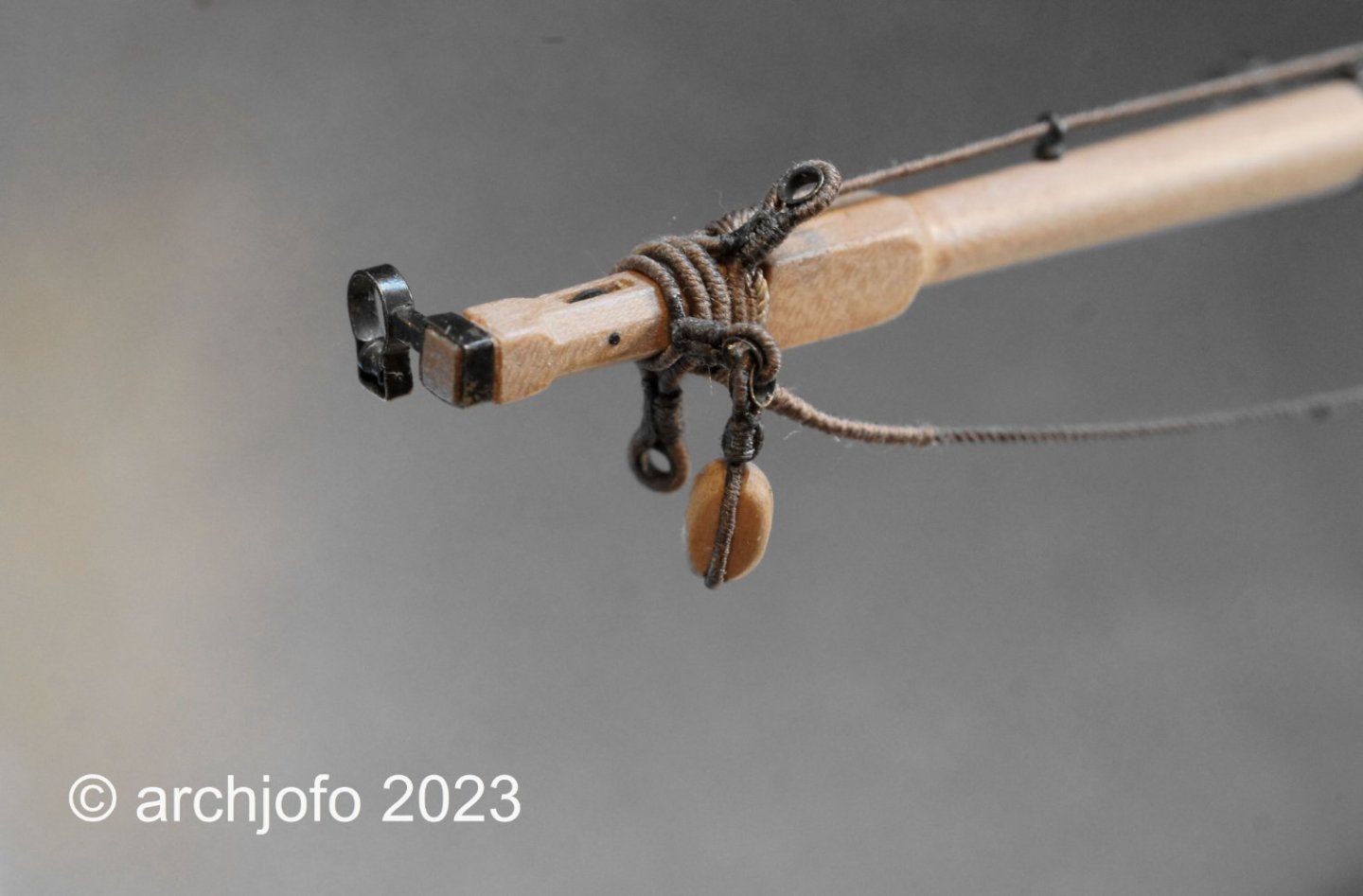
In order from the inside out, the following rigging elements are already in place:
- Grommet strop
- Jackstay
- thimble strop for clew
- footrope
- Strop for yard tackle
- Strop with brace block
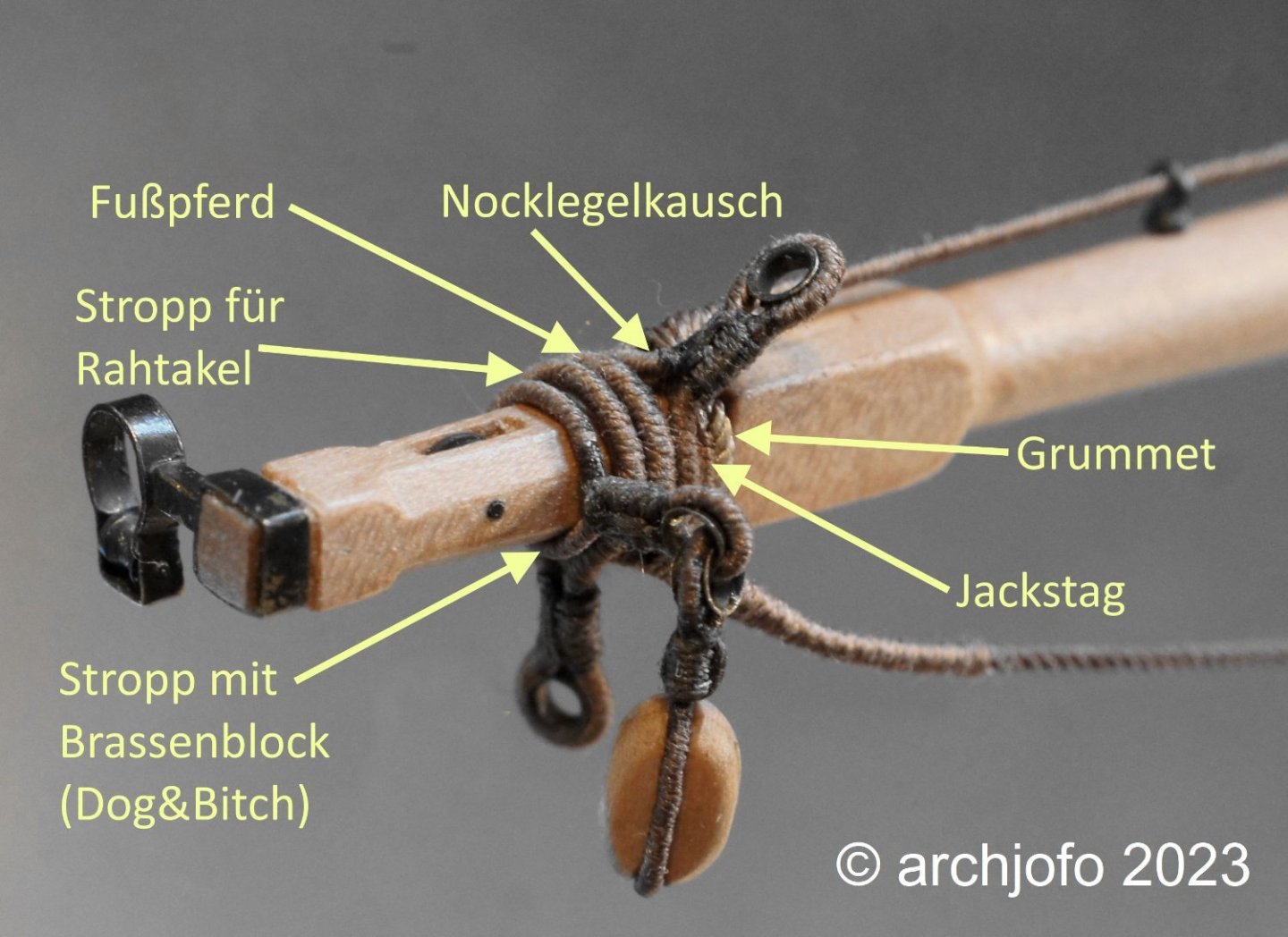
Finally the lifts and the fore yard sheets are missing, as well as the studding sail booms
To be continued ... -
-
Thank you very much for the nice comments. Thanks also to everyone else for the many LIKES.
Hello fellow colleagues,
back from Italy I escaped straight to the cool basement shipyard ... 😁
But apart from a few "finger exercises" I didn't get much done. I guess I have to "groove in" first, to put it drum-wise... 😁Continued: Equipment of the fore yard -footropes and stirrups - Marchepieds et étrier
In the meantime, the footropes and stirrups for the fore yard have been completed. With the help of the following photomontage I just want to give you a few more insights into the production of the details.
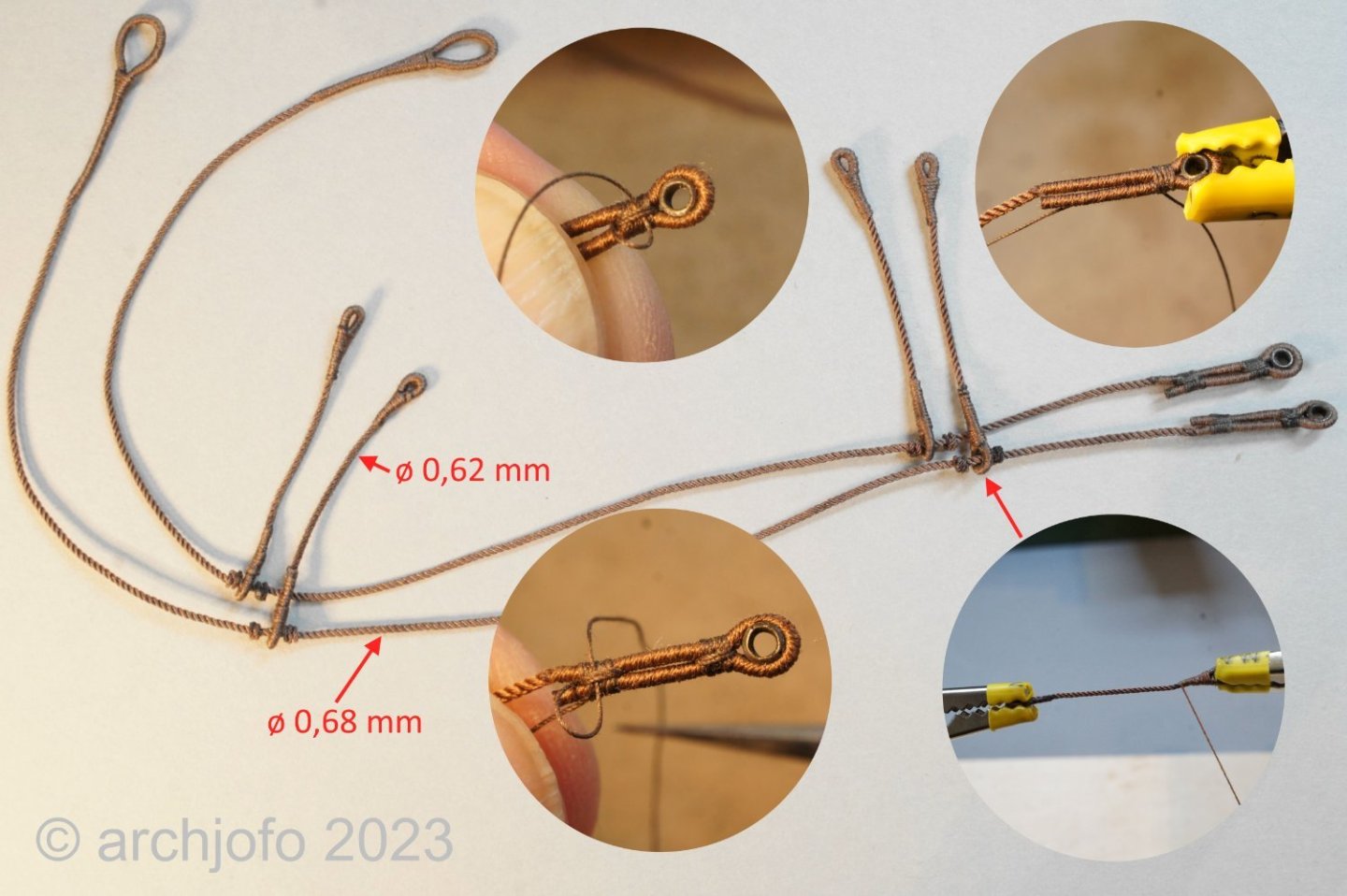
On the next picture I show the current equipment level of the fore yard, where not too much is missing anymore. -
That is very true, and I think that one or the other was involved with a specific work.
Glad I could give you a suggestion. That is an honor for me.
Glad you like it.
The rose lashings looks more difficult than it actually is. Just give it a try.I hope not ... 😁
Thanks to all for the interest and the LIKES.
Continuation: Equipment of the fore yard - Jackstay / Filière d`envergure; Blocks for buntlines and clewlines / Poulies de cargue fond et poulies de boulin
I would like to explain the installation of the jackstay in a little more detail using the fore yard as an example. According to my research and the Paris model, the jackstay was completely served to obtain the required stiffness. The eye splices for the yard arms and the thimbles of the tackle in the center of the yard were also served.How to implement this for the model in conjunction with the eyebolts?
The solution is a bit tricky, but quite feasible, as shown in the following photo collage. I think the pictures are so far self-explanatory.
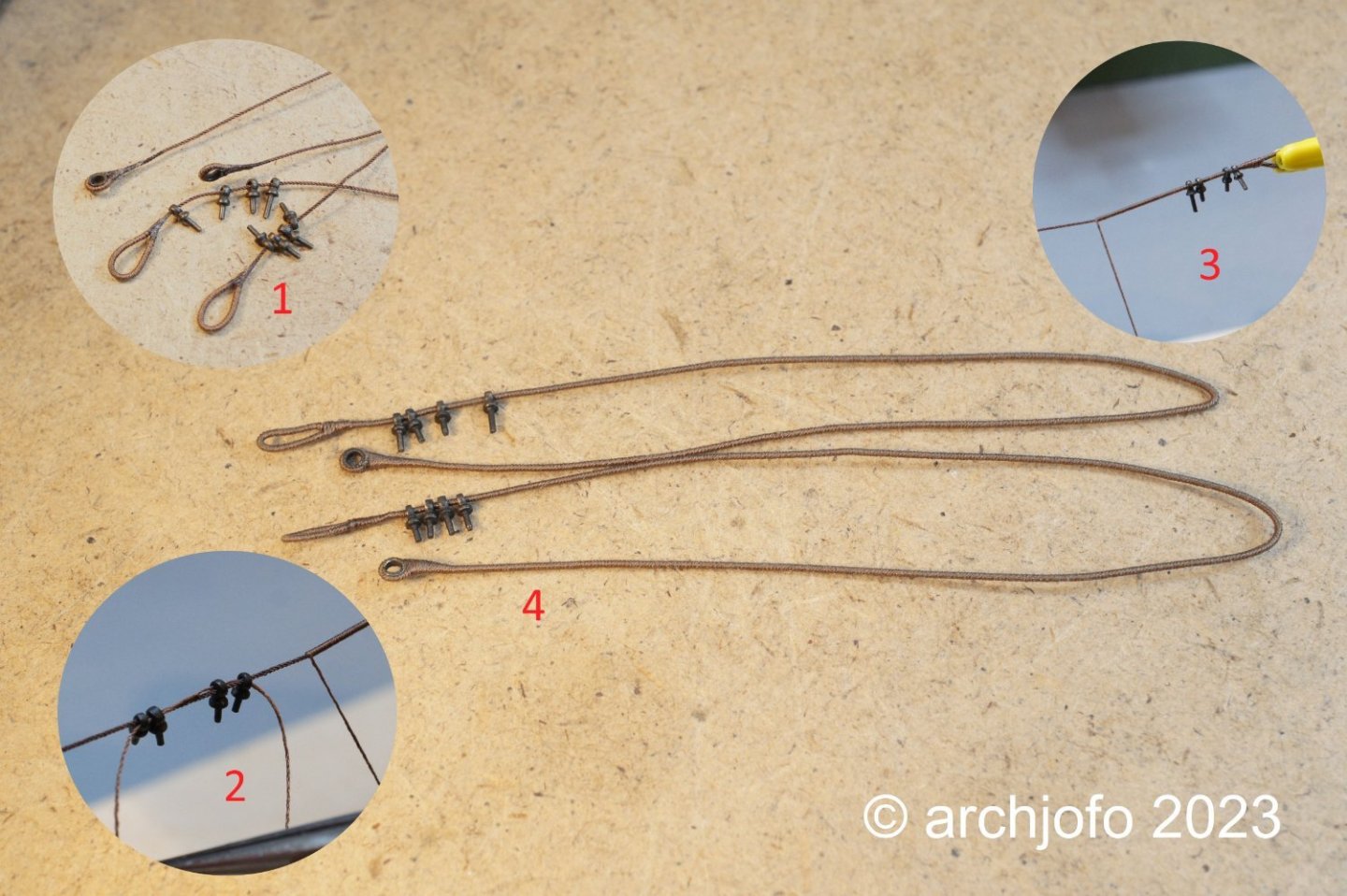
The assembly on the yard, on the other hand, was very easy to accomplish.
The rope for the tackle was pulled in and lashed as well as the blocks for buntlines and clewlines were already attached. -
Continuation: Equipment of the fore yard -Truss pendants / Drosse d'une basse vergue
As announced, I made the truss pendants for the fore yard. The truss pendants consists of two partly served ropes, at each end of which a thimble was spliced in. In the following picture you can see how one side of the truss pendants is attached to the yard by means of lashing. Later it will be moved to the right position.The next picture shows the finished truss pendants. Admittedly, it looks a bit wild, but I think you can see it so far.
In this context, I show an illustration that once again clarifies the functional principle of the truss pendants. Unlike the British, where the ropes went to the deck for mooring, the French led the rope ends upward over sheave gates in the trestle trees to the top. There they were lashed down with tackles.
As with the main yard, the position of the two quarter blocks is secured with a strop so as not to be pulled toward the ends of the yards by the sheets.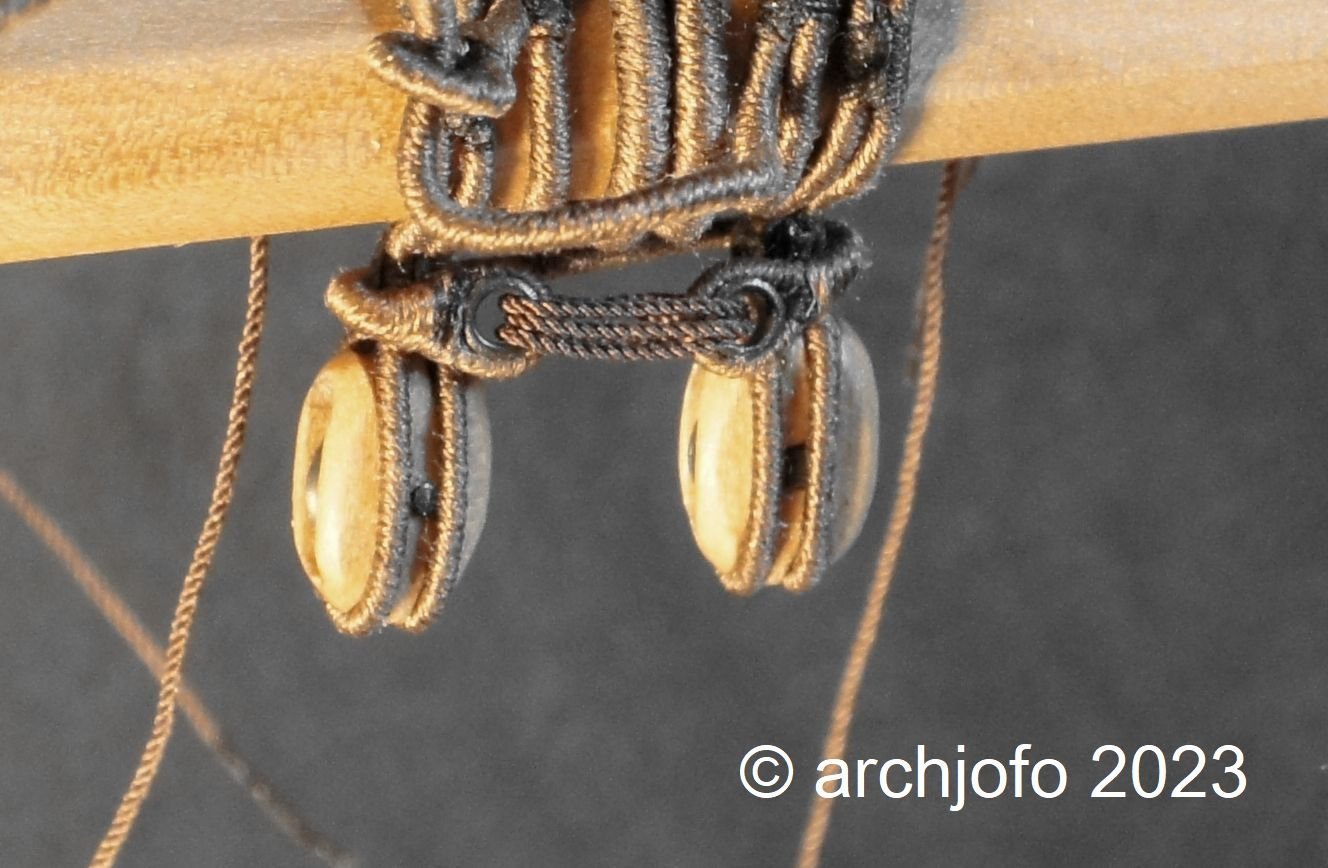
Not to be forgotten is the jackstay of the fore yard, which I will do next.
To be continued ... -
Equipment of the fore yard - Blocks for the sheets and clewline - Poulies d'ecoute et Poulies de cargue de point
At the moment I am busy with the equipment of the fore yared. Basically it is the same work as for the main yard, but everything a bit smaller. In order to avoid repetitions of the previous reports, I will try to go into one or the other manufacturing detail in more detail in this section of the work.
I tried to determine the length of the strops for the yard blocks with a thin brass wire, as shown below in the example for the sheet blocks.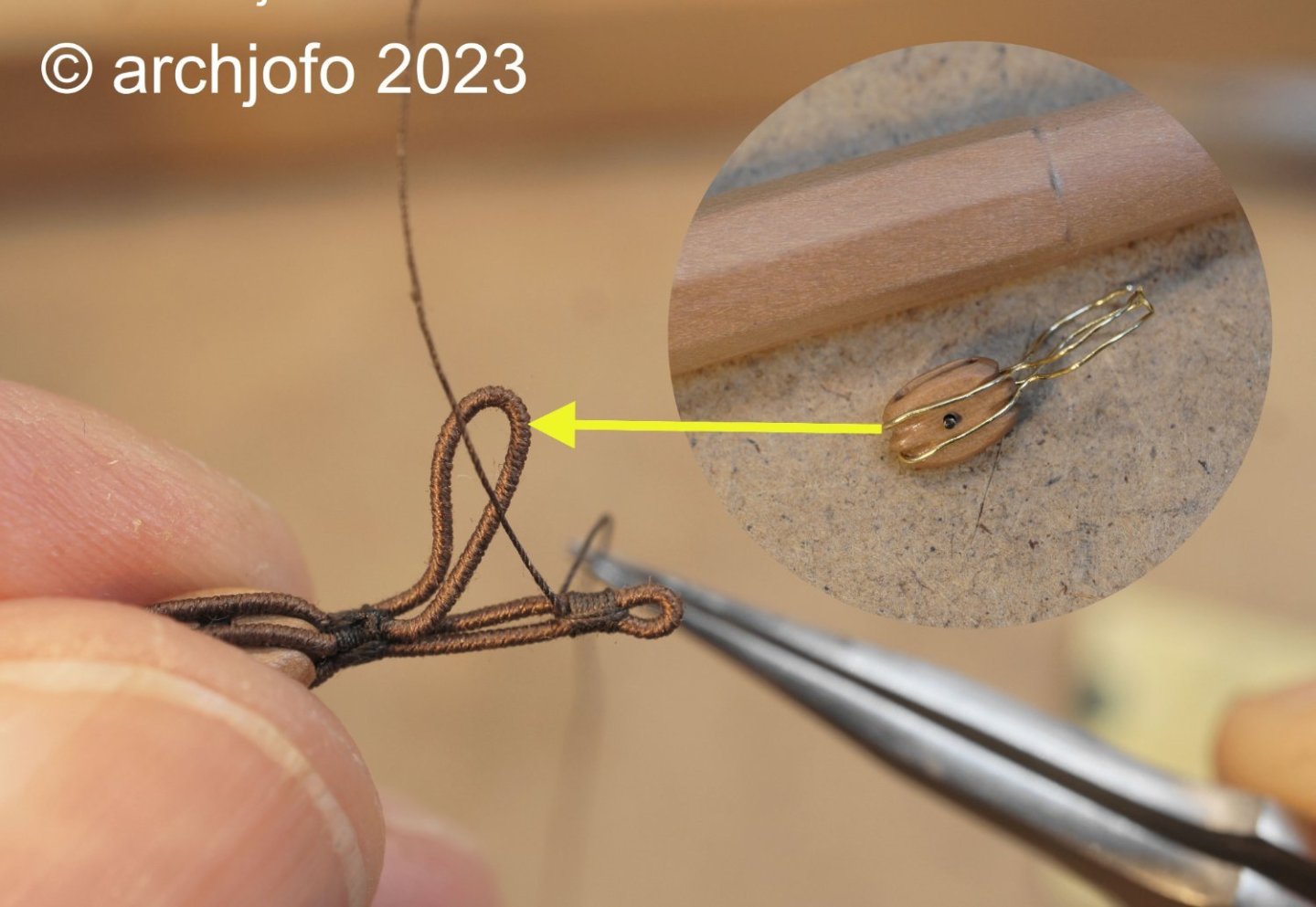
When making the strops, the areas of the eye splices are served first, and then the entire length is served between them.
The round seizings, as shown in the following illustration, I try to lay the turns as neatly as possible next to each other, and then use two strokes across to form the finish, as was probably done in the original.
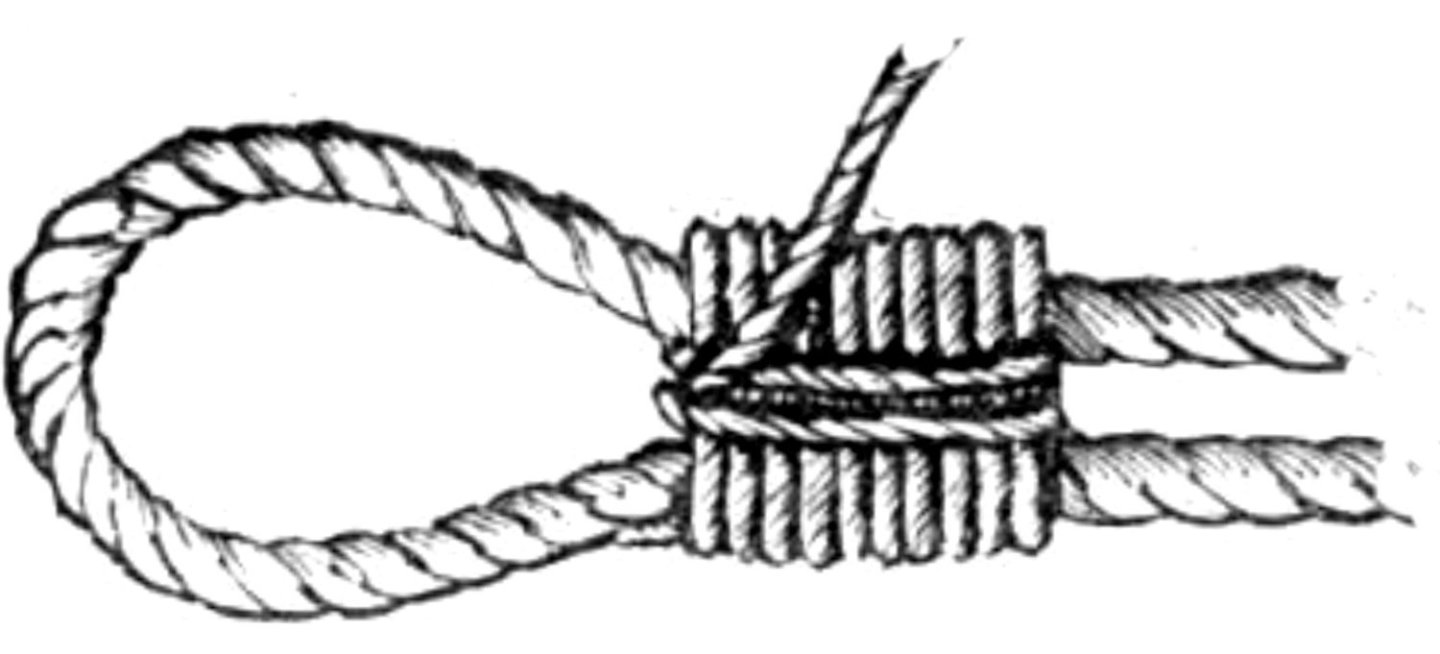
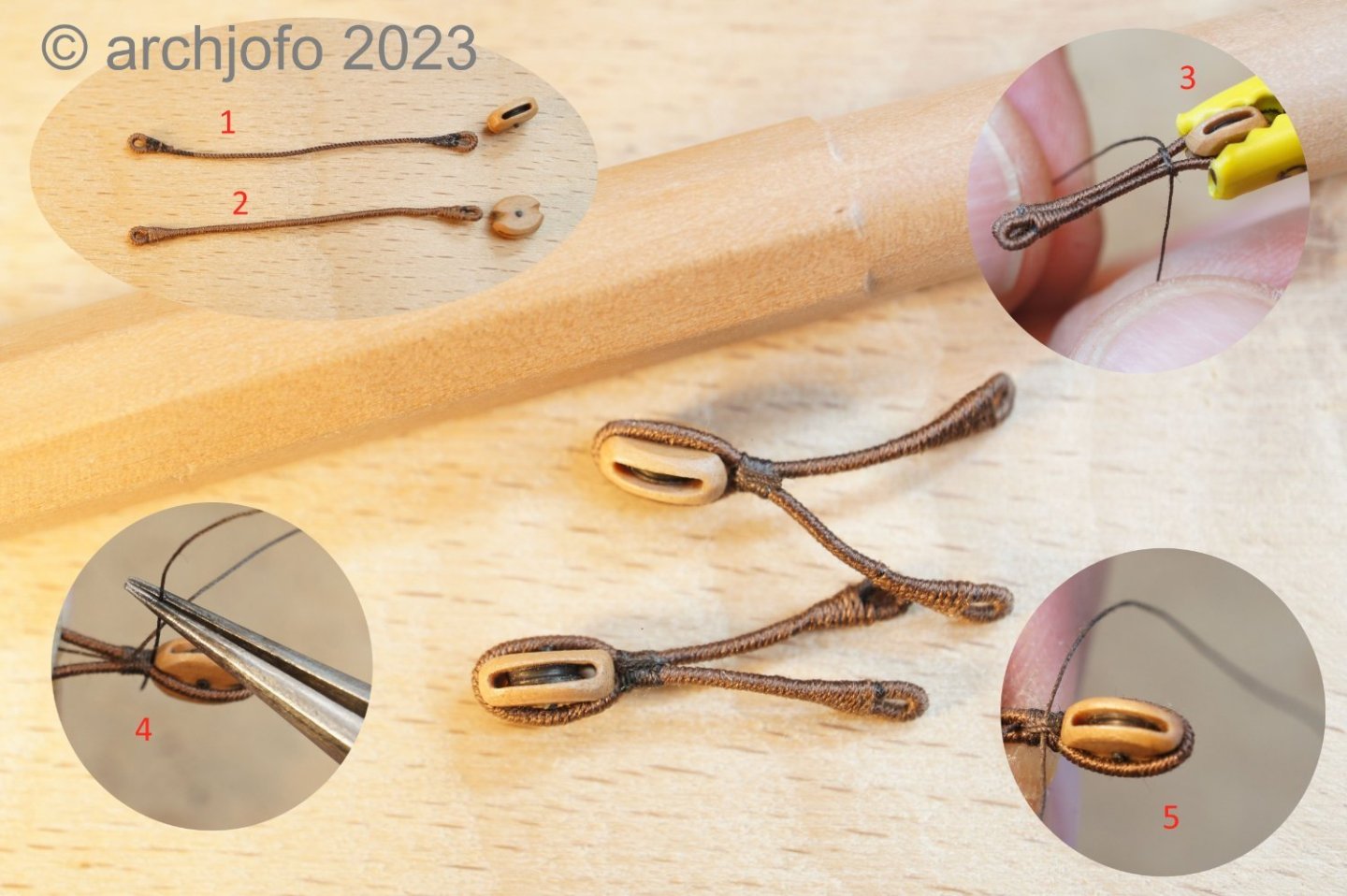
Analogous to the Großrah, the blockstrops were then attached to the fore yard at the appropriate positions using rose lashing.
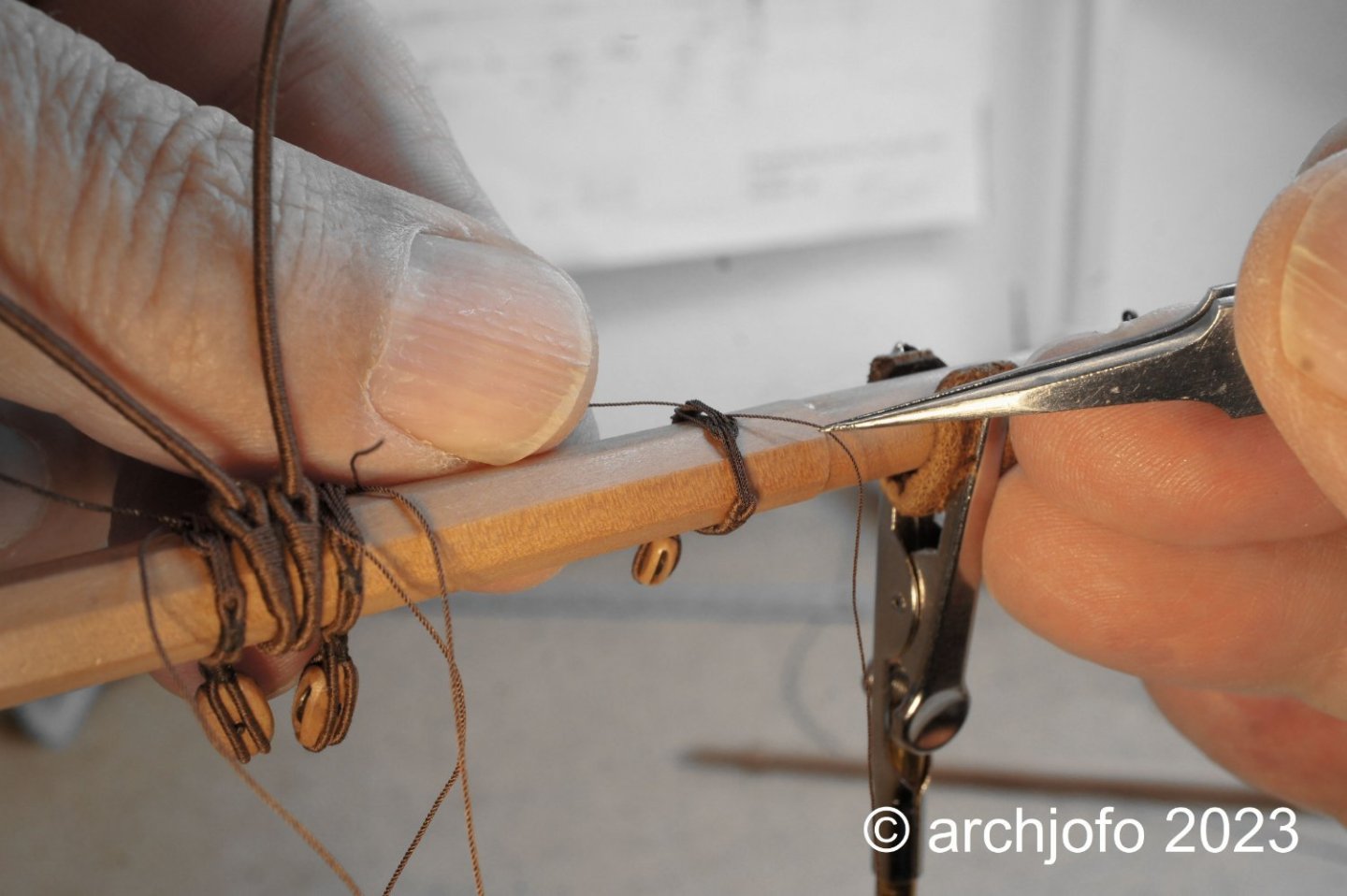
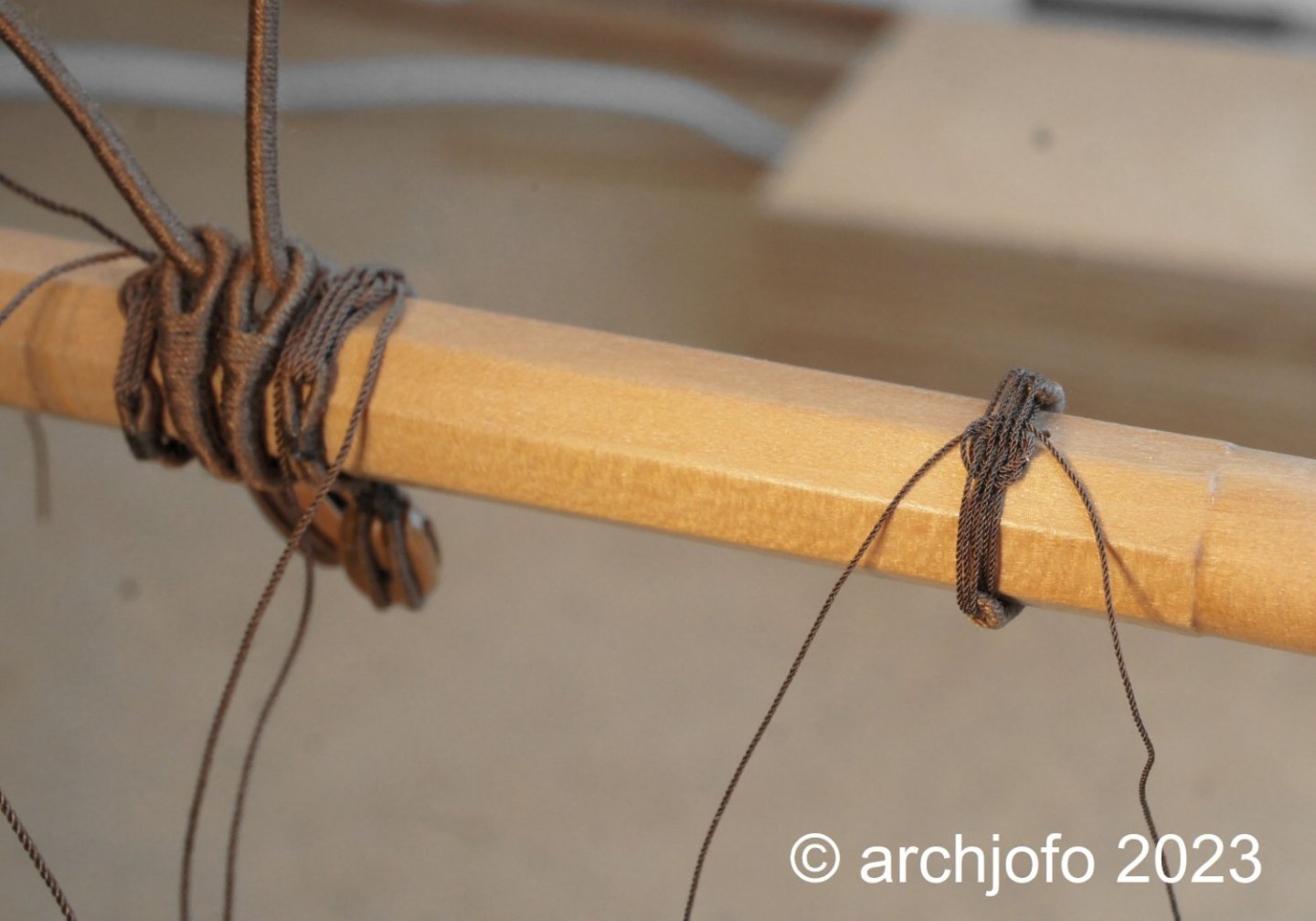
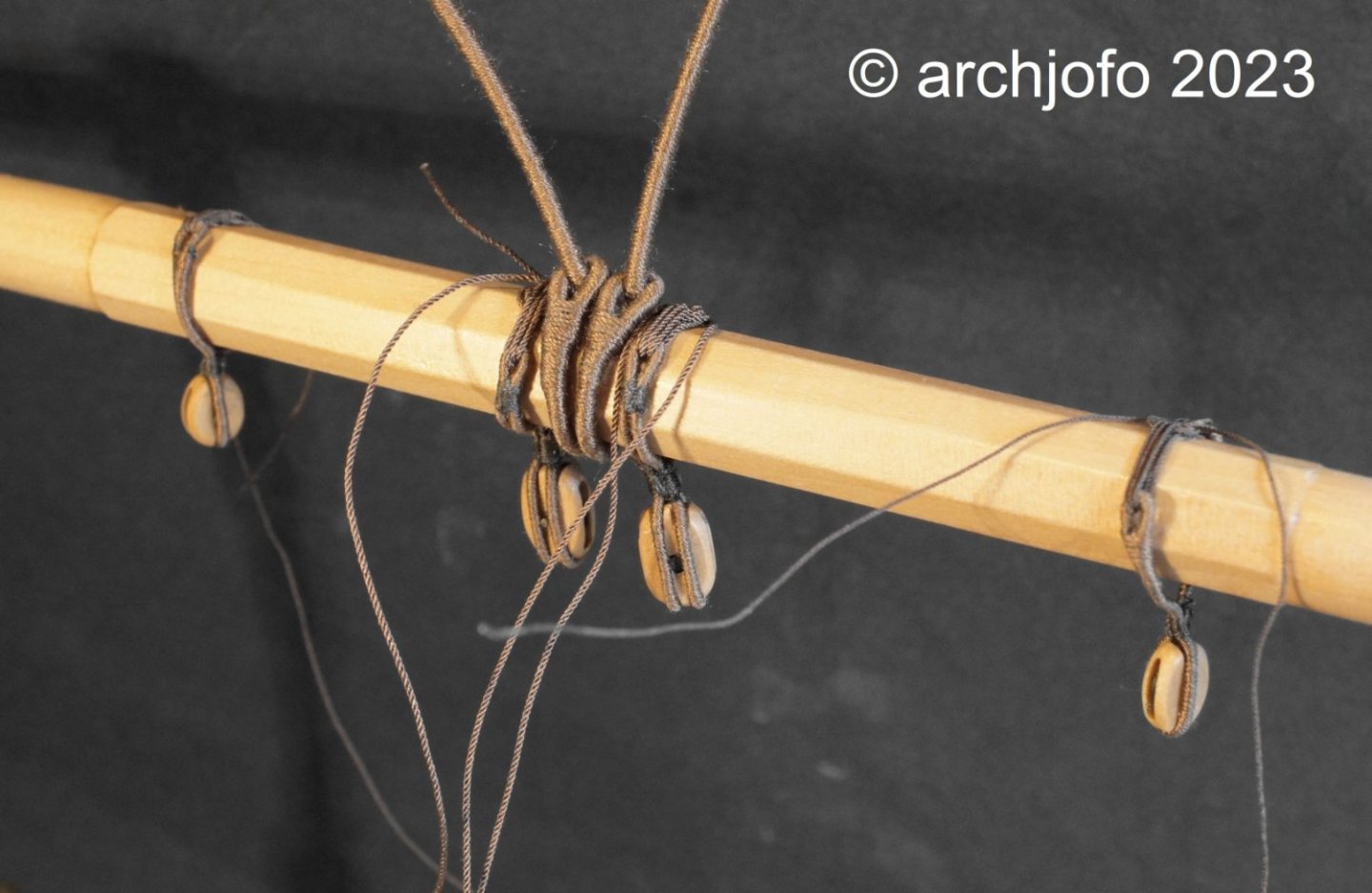
In the next step I will prepare the truss pendants with ø 34 mm (in model scale ø 0.70 mm) for the fore yard.
To be continued ... -
Fantastic work !
- mtaylor and Keith Black
-
 2
2
-
Completion: Equipment of the main yard
With the fixing of the studding sail booms to the main yard, another small milestone was reached: The main yard is finished with all equipment elements and prepared for mounting on the model, which will be done later.
In the next step I will equip the fore yard with the takele elements. I will certainly make faster progress with this, since I have already prepared some equipment parts and many clarifications of execution details have also already been made.
To be continued ... -
Thank you for your interest and positive response.
Continuation: Equipment of the main yard - Tacks and sheets
First of all, I would like to thank G. Delacroix for his interesting contribution.
In addition to his information, I was able to read the following in a French standard work on the rigging of sailing ships in the 19th century "Manuel de gréement par F.-A. Costé, Paris1829":Thus, in the time of the La Créole, the tacks and sheets of the lower sails were definitely also made of Grelins (cable-laid ropes).
In addition, these also served for the standing parts.In any case, a very interesting information, which I will try to implement adequately on my model.
Here are the first attempts to make a "Grelin":
See you soon ....
-
Hello,
cable-laid should be correct.
In the meantime I have found a description of the French terms for this type of rope on the Internet:
- shipman, Jack12477, G. Delacroix and 9 others
-
 12
12
-
Hello,
many thanks for the quick response.
For better understanding, does cable mean cable-laid?- Keith Black, Jack12477, mtaylor and 1 other
-
 4
4
-
I am grateful for the interesting clarification on the tarring of cordage and I was happy.
So I didn't do much wrong in that regard.
Can you say something about the type of cordage for the tacks and sheets for the main and foresail?- Keith Black, Jack12477, Siggi52 and 2 others
-
 5
5
-
@jfhealey
Thanks for the nice comment.
Continuation: Equipment of the main yard - arrangement of the blocks for the clewlines, sheets and tacks - Bouquet de manouvres de grand voile
Since I intend to equip the yards with all the necessary rigging elements, I will also prepare the arrangements for the blocks of clewlines, sheets and tacks and pull in the necessary ropes. These elements are not present on the original model in Paris.
In the meantime I have made the corresponding single blocks for the main yard including the toggles (no stopper knots).
In doing so, I start from double tacks, as they are also provided for in the monograph and became more or less common at the beginning of the 19th century. In this respect, the question of the rejuvenated tacks should have been settled, right?
The question remains as to what type of ropes were used.To attach the Clewlines ø 17 mm (ø 0.35 mm on a scale of 1:48) to the yards, so-called timber hitch were most likely used, as shown below.
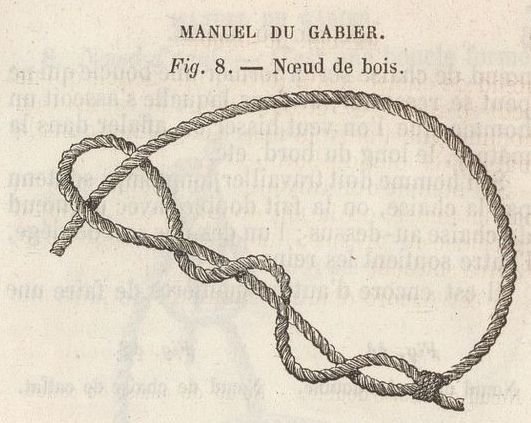
Source: Manuel Du Gabier, 1875
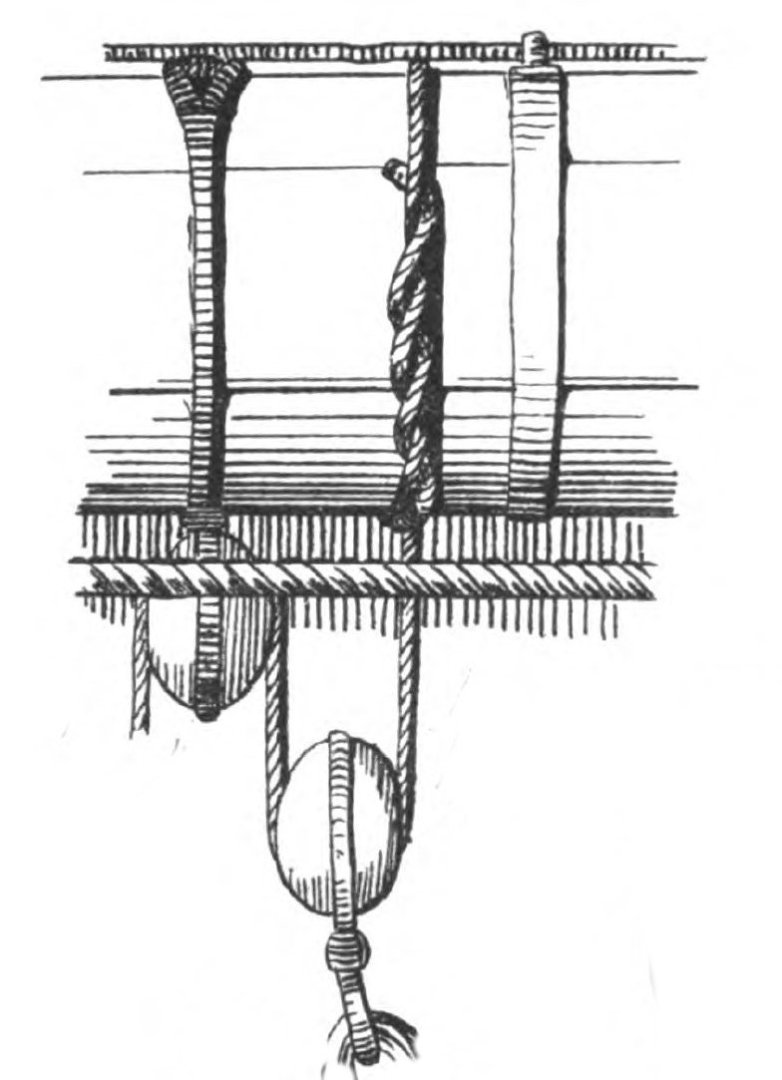
Source: Handbook of Seamanship, Franz Ulffers, 1872Of course, when rigging a model, everyone inevitably comes to the point where the question arises as to how the block strops of the running rigging should be executed in terms of colour. Either hemp-colored, or brown to black as tarred cordage. I read somewhere that anything that moves doesn't get tarred, and anything that doesn't move gets tarred. This can also be seen on the rigging of the L'Hermione replica, so I use it as a guide for my model.
This is how the finished arrangement for the blocks for the clewlines, sheets and tacks looks like:In a hurry, I accidentally made the attachment inside. Of course, this has to be done on the outside towards the yardarm and is still being changed.
-
Hello Brian,
the ropes are made of silk. The two ends were glued with superglue at the point marked in yellow. In order to create the largest possible contact surface for the glue, I cut off the two ends at an angle with a scalpel.
Thank you for the interest. -
Hello,
getting such great praise from such an excellent model builder is also something very special.
Thank you very much for that.I would also like to thank all the others for the many LIKES.
- mtaylor and Keith Black
-
 2
2
-
Thank you for your interest and the kind words.
Also many thanks to all the others for the LIKES.Continued: Equipment of the main yard - Blocks for buntlines and clewlines - Poulies de cargue fond et poulies de bouline
In the meantime I have made 12 blocks l = 3.4 mm for the blocks for buntlines and clewlines of the lower yards. I tried to make the seizing as small as possible, which wasn't easy with this size.
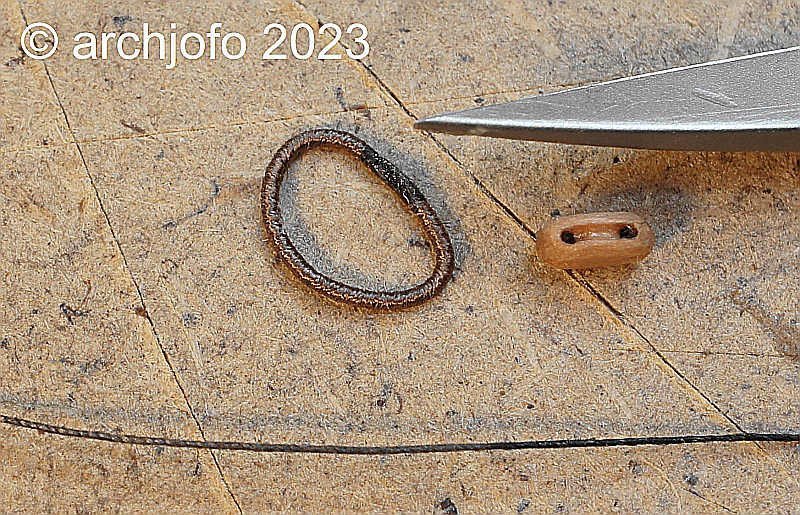

These blocks were moored to jackstay as shown in the following images.
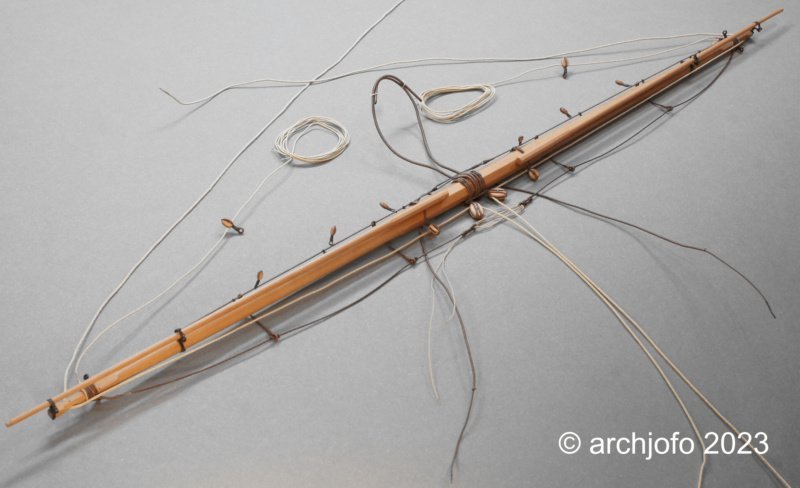
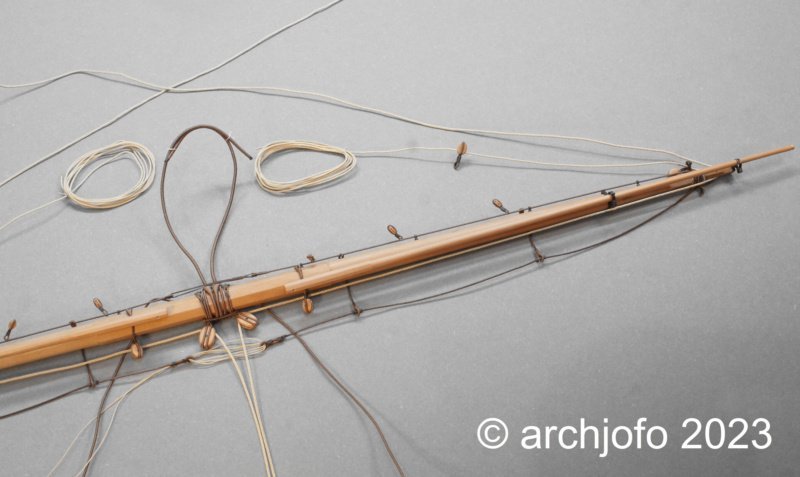
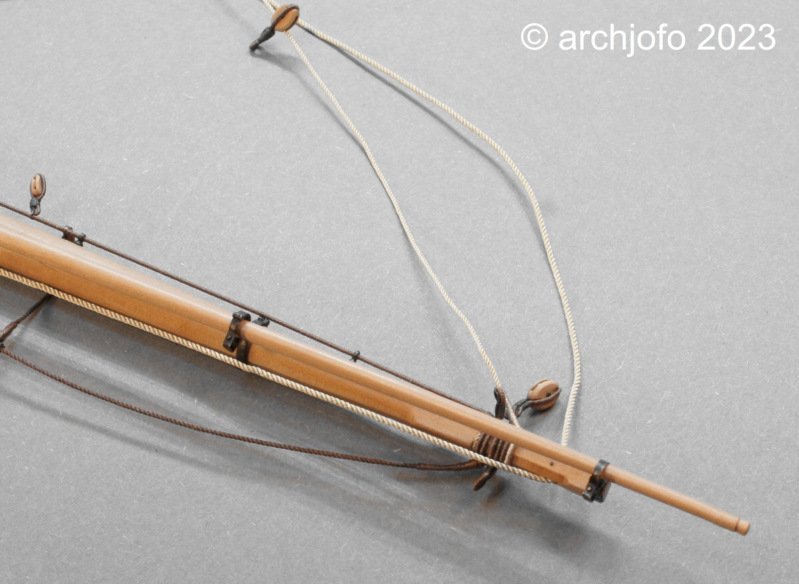
I will make my model of the La Créole without the sails, as I have already mentioned several times, analogous to the Paris model. Nevertheless, I would like to attach the arrangement for the clews of the lower sails. These rigging elements are not shown on the original model, so the sheets, tacks and clewlines with the necessary blocks are missing.
At the moment I'm still researching whether single or double tacks were used at La Créole. It still needs to be clarified how the fore tacks were led to the mooring cleats, as there is no information on this in the monograph. There is also another question, whether the French also use cable-laid ropes for the tack ropes?
Up soon …
-
@BobG
Hi Bob,Thanks for the positive affirmation.
I would also like to thank you for the many LIKES.Continued: Equipment of the big yard - Blocks for buntlines and clewlines - Poulies de cargue fond et poulies de bouline
According to the relevant table in the monograph, the blocks for the buntlines and clewlines are only 3.4 mm long and 1.3 mm thick at a scale of 1:48. With this block size, the sheaves with a thickness of d= 0.5 mm are not used separately, but worked out. In total I need 12 blocks for the main yard and fore yard.
Before I start "series production", I made a "prototype" in the usual way and equipped it with a served strop. The eye is used to attach to the jackstay.
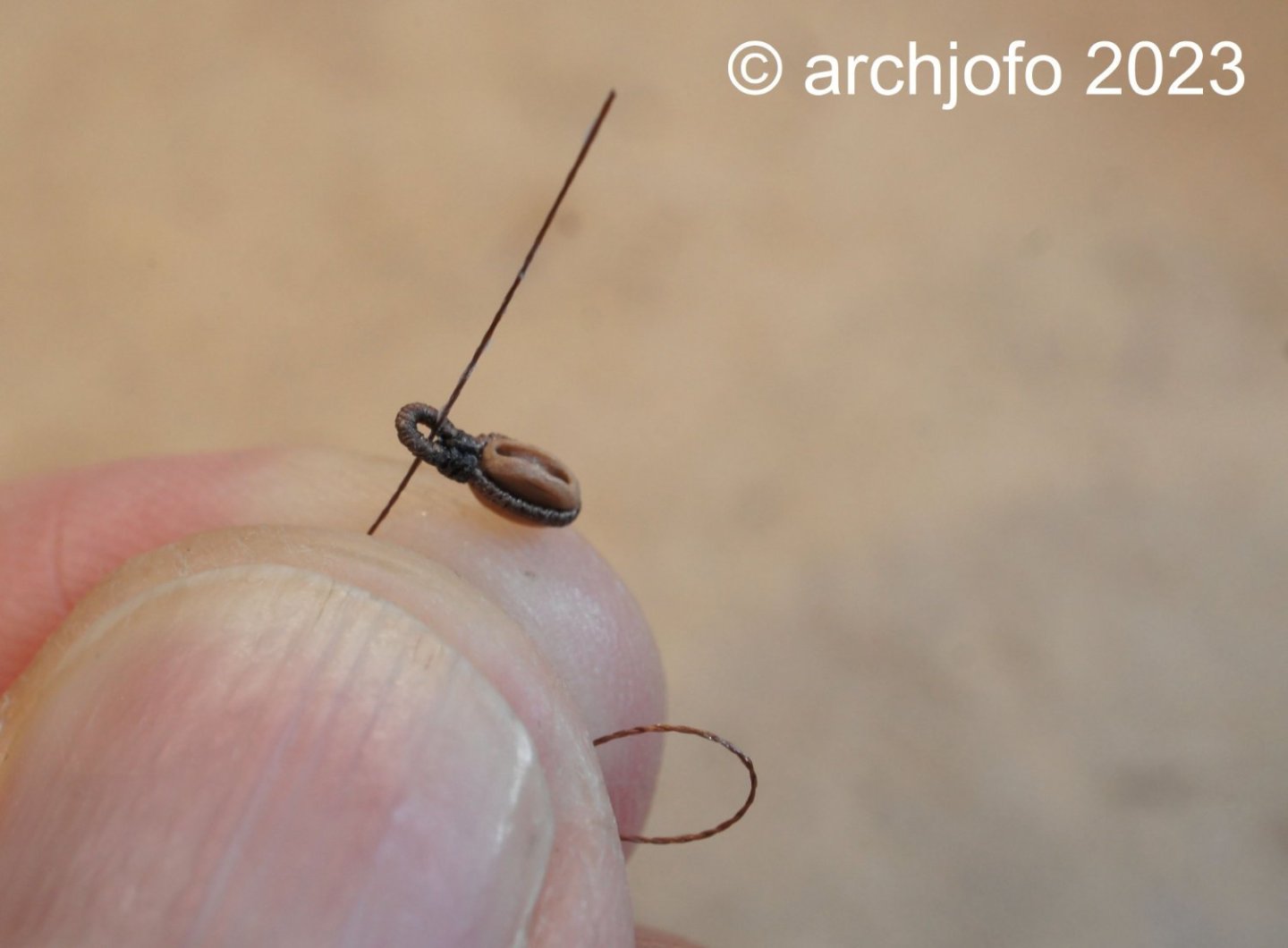
In the following image I have shown different block types and sizes compared to a block for a buntlines.
The next picture shows how these blocks are attached to the jackstay by means of tying.
Sequel follows …
-
Hello,
Thank you for your positive comment.
I would like to thank the others for the LIKES.Continued: Main yard equipment and others - Footropes and stirrups - Marchepieds et étriers - etc.
The blocks for the La Créole's braces were attached directly to the yard arms by strop. The connection of the blocks for the braces with the thimble sling was called "Dog and Bitch".
In addition to the strops for the braces, strops for the yard tackles also had to be considered, as can be seen in the following picture.
The yard tackles were then only attached when needed. In connection with the stay tackles, e.g. B. the boats are loaded and unloaded. The next picture shows the main yard with the newly installed rigging elements. For the lower yards, this corvette had simple yard lifts with a diameter of 30 mm, which went over blocks hooked into the tops for belaying on deck. The yard arms are now fully occupied. The footropes and stirrups that have already been attached still have to be properly lashed down in the middle of the frame.
I still have to clarify in detail to what extent these lanyards can still be lashed over the sling of the lower yard, as shown in the following drawing by Nares. Unfortunately I don't have a meaningful picture of the original model.Source: Traité de manoeuvre et de matelotage, George S. Nares, 1868
The attachment of a stirrup to the jackstay can be seen in the next detailed pictures.
Finally a picture of the middle of the yard.
Except for the blocks for the clewlines and buntlines and the professional attachment of the stunsail booms, the main yard should then be fully equipped.
I would not have thought that so many rigging elements would have to be attached to a yard. I learned a lot from the research I did on the internet and relevant specialist literature. In the lower yards that follow, the production of the equipment should be all the faster. For the topsail, topgallant and royal yards, on the other hand, some detailed information is required that still needs to be obtained.
Sequel follows … -
Thank you very much for the nice comments.
Thanks also to everyone else for the LIKES.Continued: Equipment of the lower yards - footropes and stirrups - Marchepieds et étriers
The arrangement of the footropes on the yards should be given as realistic an appearance as possible. In this respect, it is desirable to bring the stirrups vertically downwards and to let the drawn-through ropes of the footropes sag in their natural form.
In order to achieve this on a model scale, of course, a little help has to be given.
When making the yards, I initially made the main yard with incorrect yardarms. With this leftover yard I have already carried out tests on the arrangement for the jackstay. Now it serves me once more for experiments regarding the footropes. In this respect, I made provisional footropes and stirrups and installed them at the test yard.
After the ropes, which have been coated with diluted white glue, have dried and draped accordingly, the footropes look like the following picture:

In the right area of the yard it does not seem to be quite optimal and overall the sag is too big in my opinion, but I think that with this method I can achieve a good result for the model.
Soon... -
Thanks for the LIKES, I'm very glad you like it.
Continuation: Equipment of the lower yards - footropes and stirrups - Marchepieds et étriers
In the meantime the ordered brass tubes with various diameters arrived. In this respect, I found out that matching thimbles with ø1.8 mm for the jumpers can be made from brass tubes with ø1.1 mm.
The stopper knots presented another challenge. To prevent the footropes from being pulled through the thimbles, for example, so-called "Turk's head knots" were woven in.
How are these knots to be depicted reasonably realistically in 1:48 scale?
Simple overhand knots do not look very good. After a number of attempts, I found a solution that looks reasonably acceptable in my eyes, as shown in the following picture.
On the next picture the footropes and stirrups are ready for the next step.
The stopper knots were now placed in the appropriate places as described before, and the stirrups were pulled in between. The original footrope was actually covered with leather between the stopper knots to prevent shame.
Four stirrups were sufficient for the lower beam lengths of a corvette.
Before I attach the footropes to the yard, I consider how to achieve the most realistic hang. From the top of the yard to the footrope a distance of about 1.05 - 1.10 m should be chosen. This way, the sailors could support themselves well with their feet and work hanging belly-down over the yard.



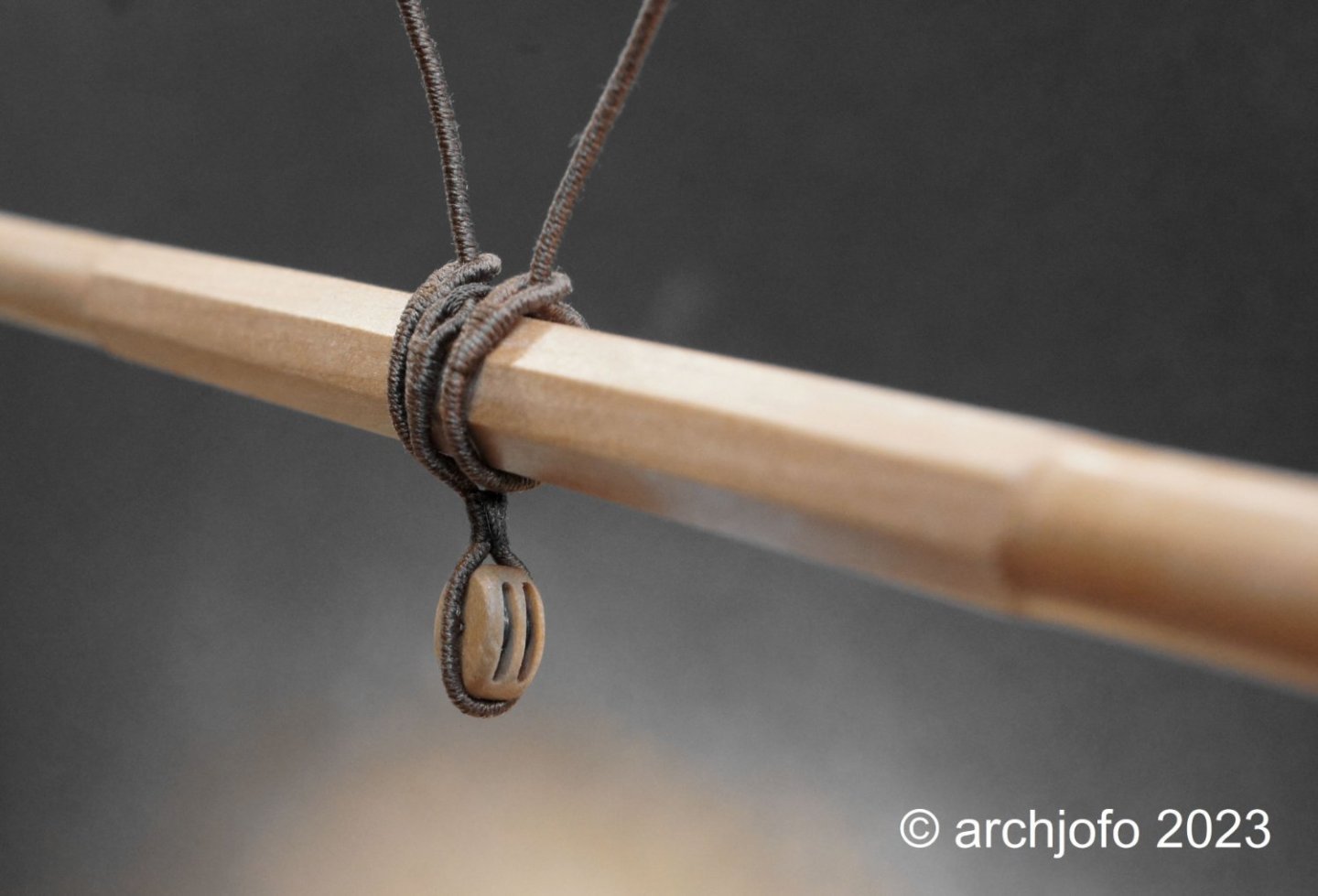

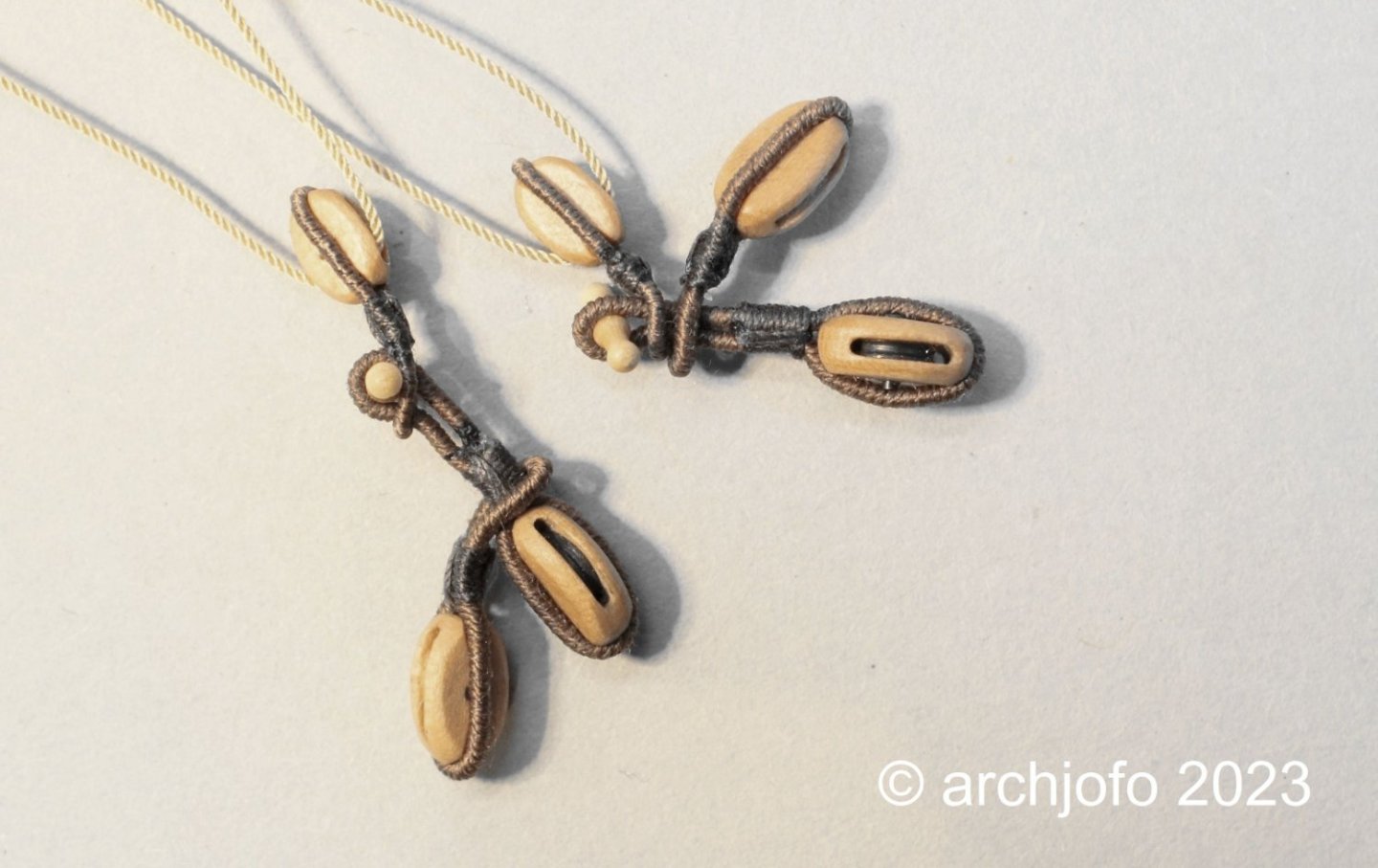
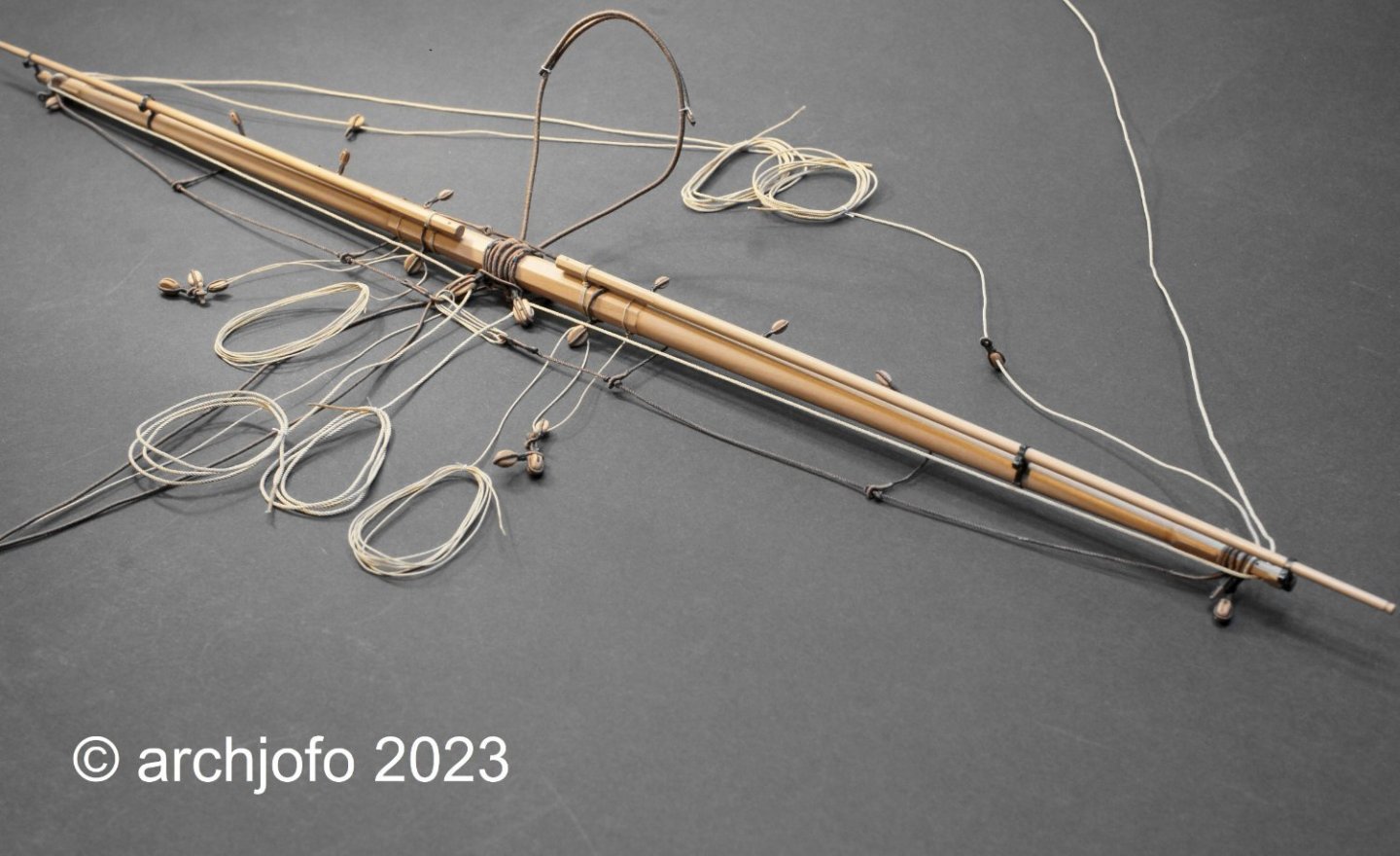
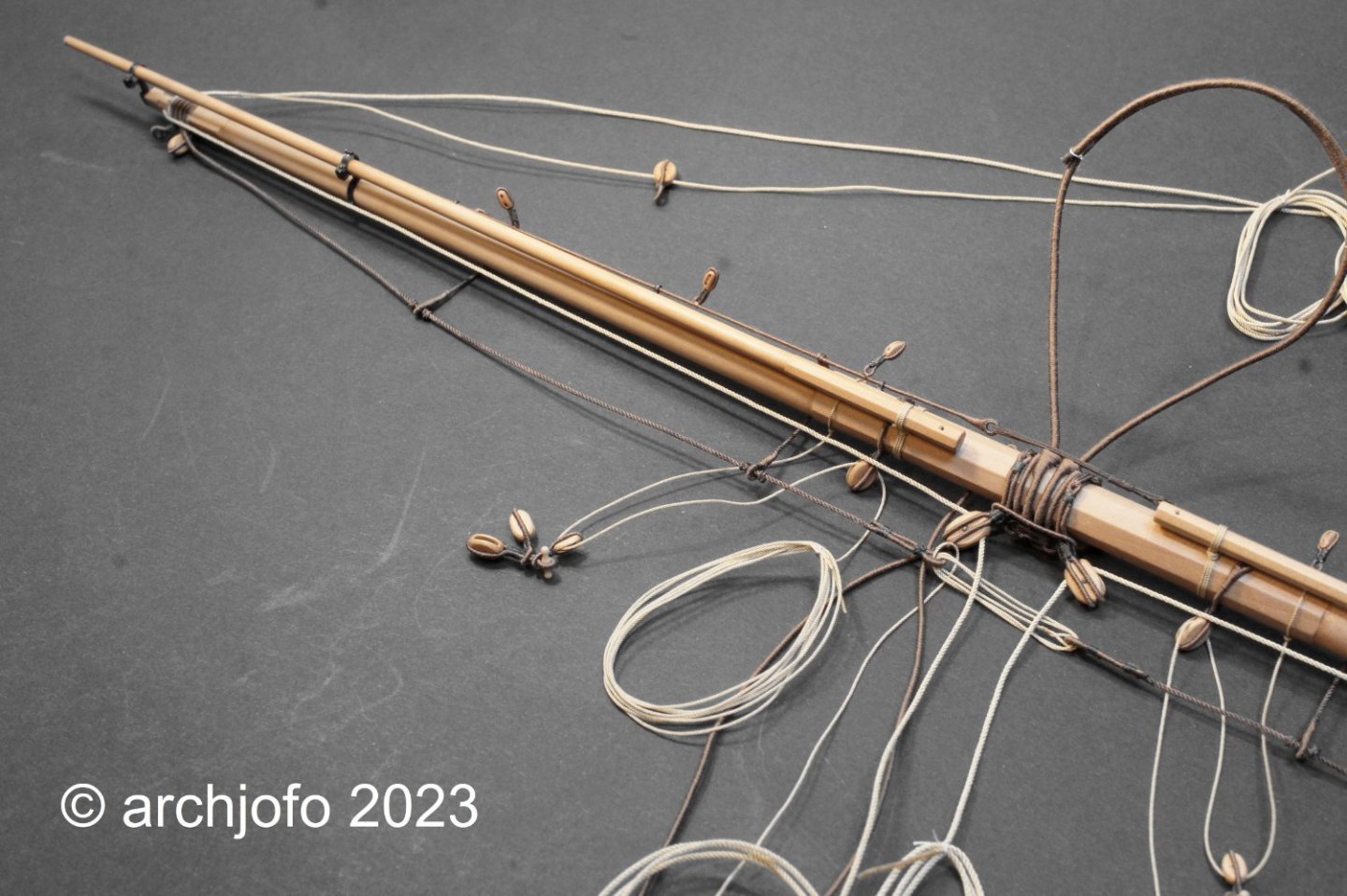
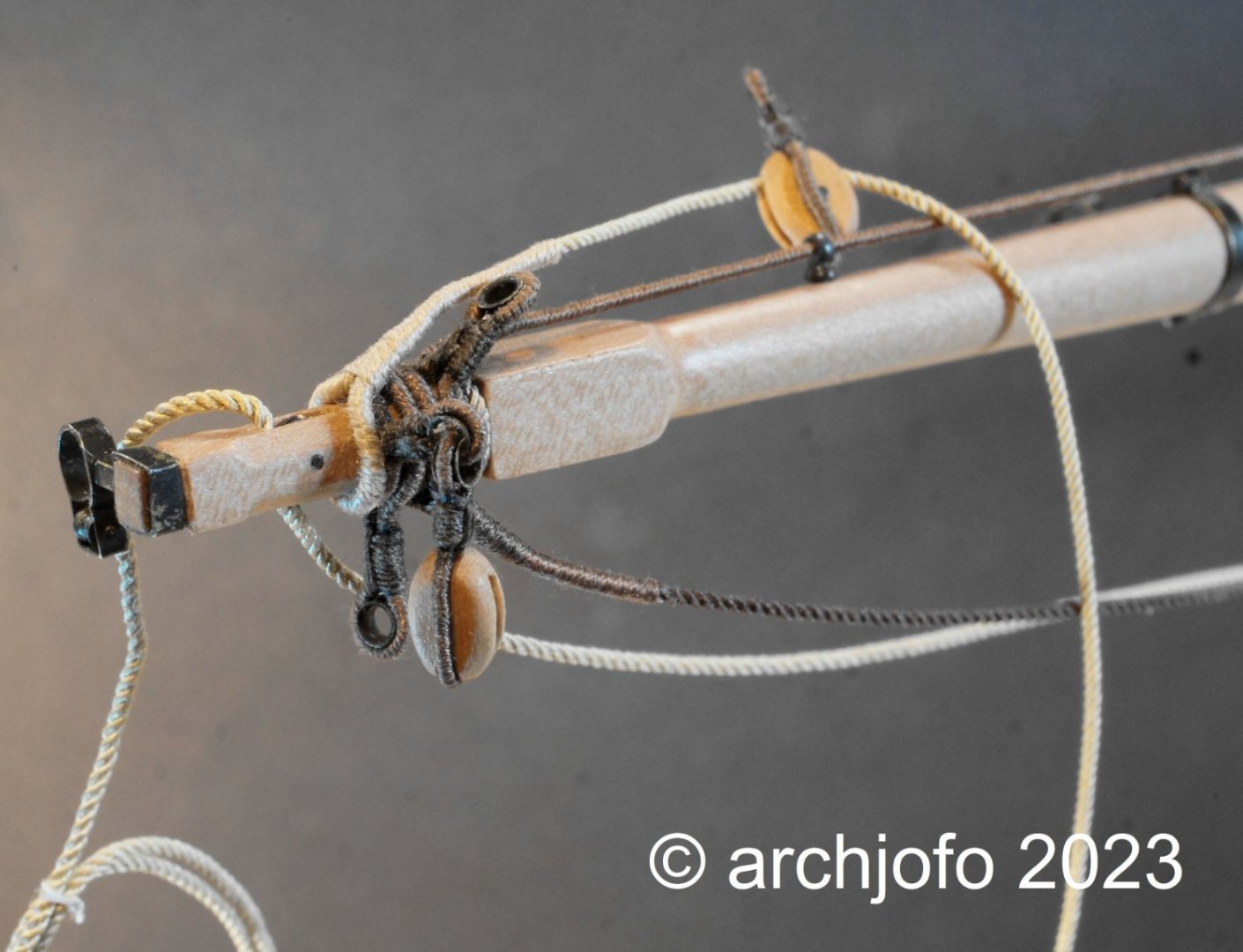
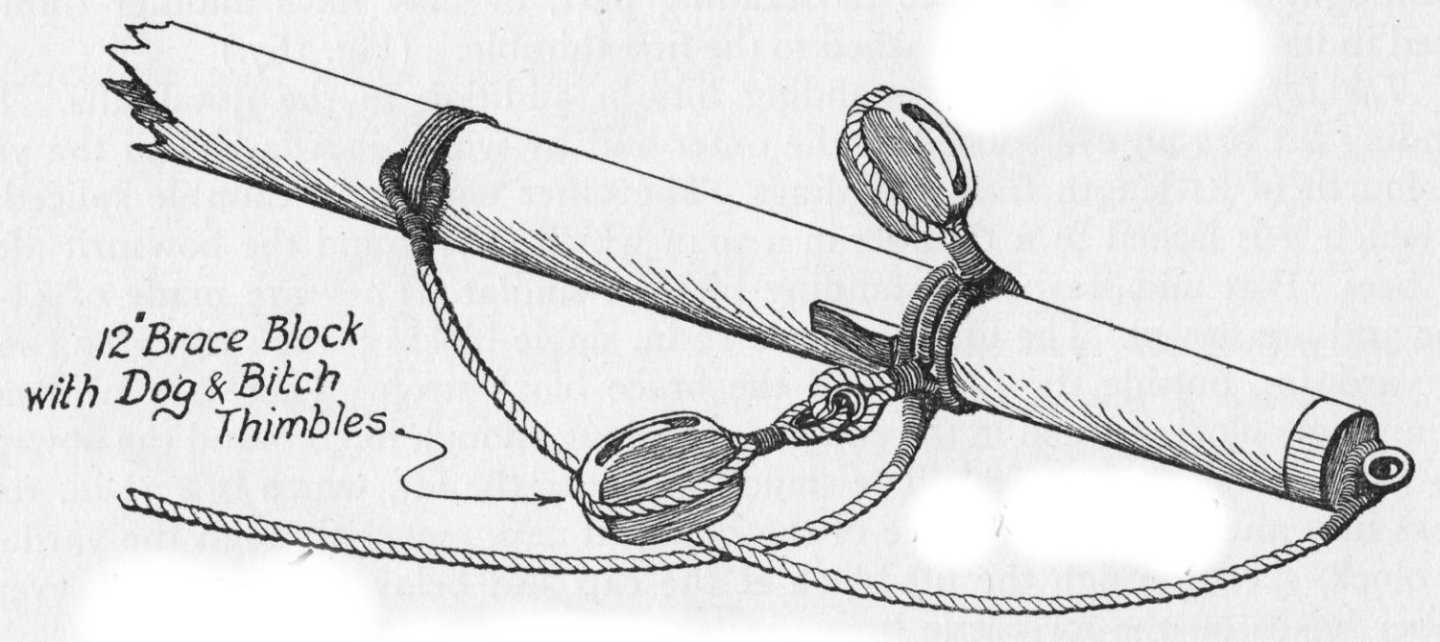
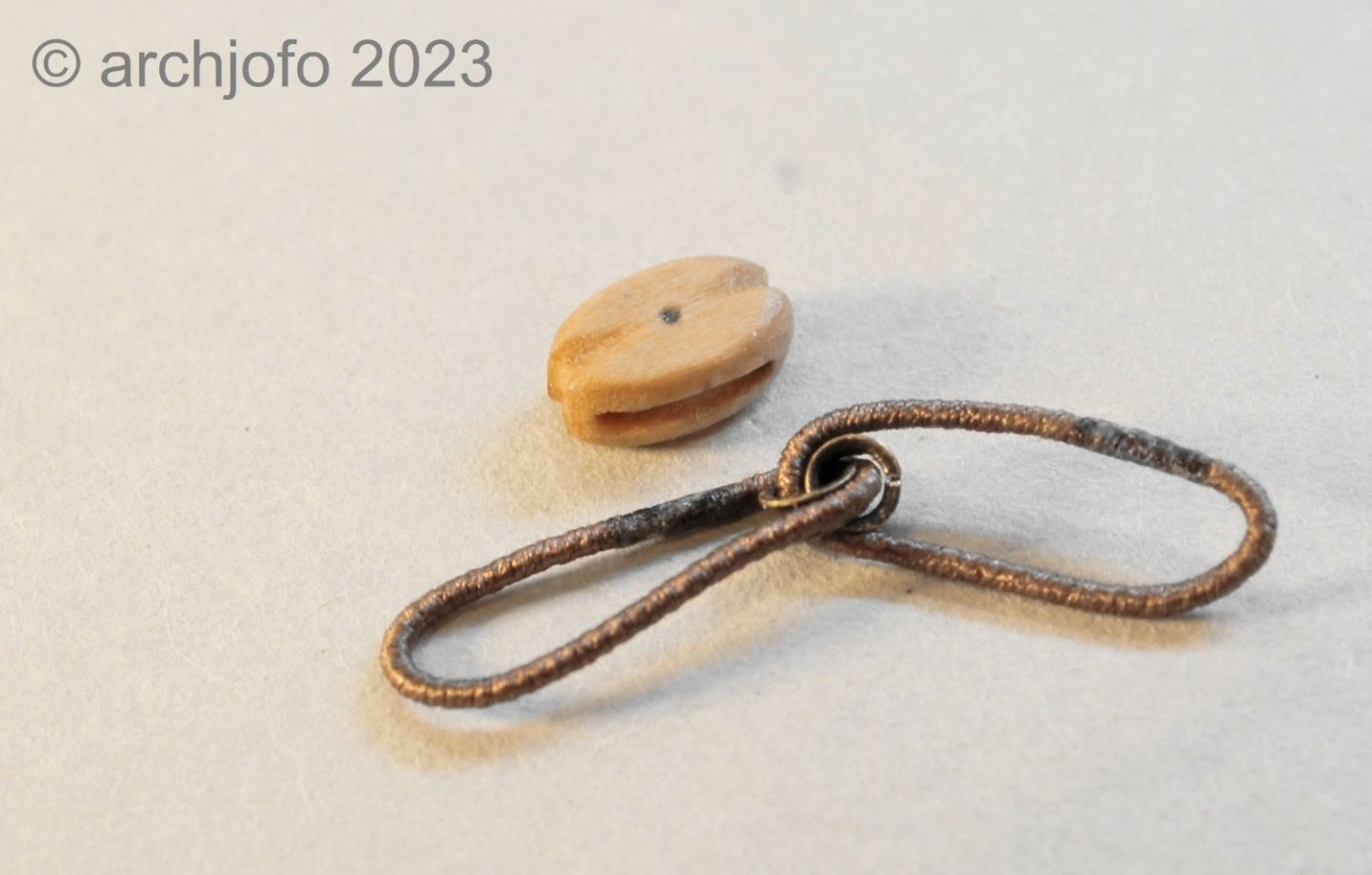

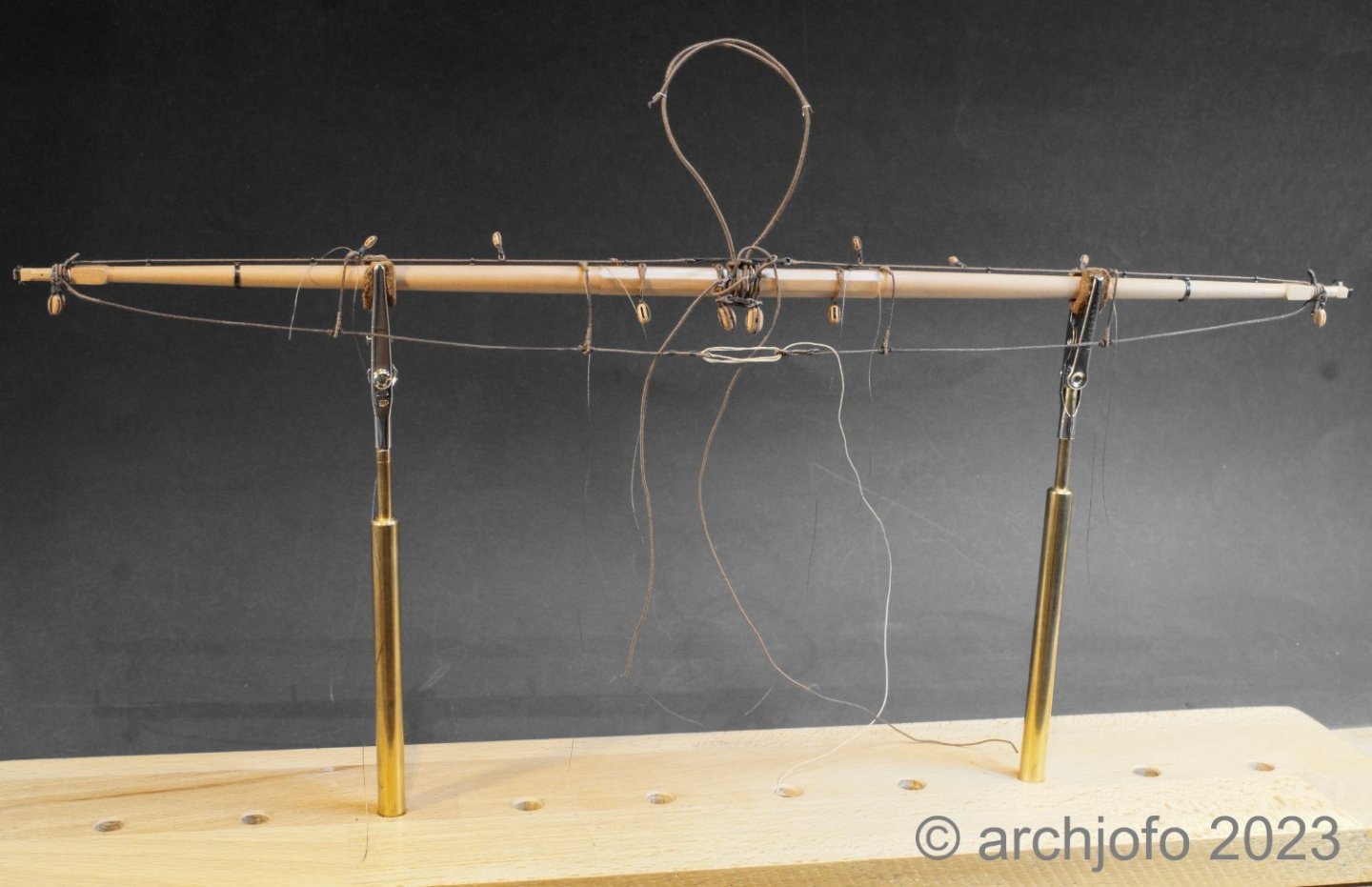
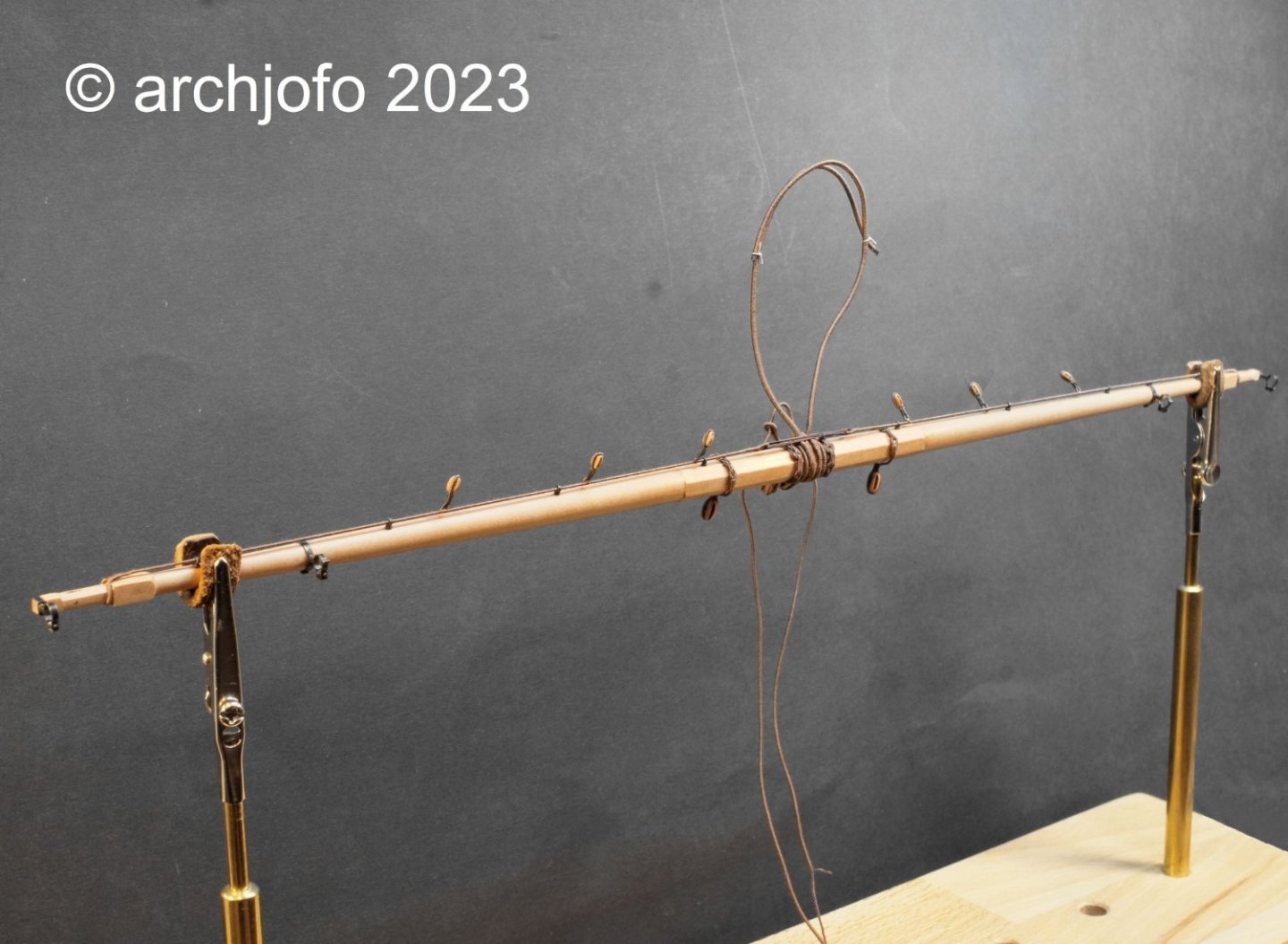
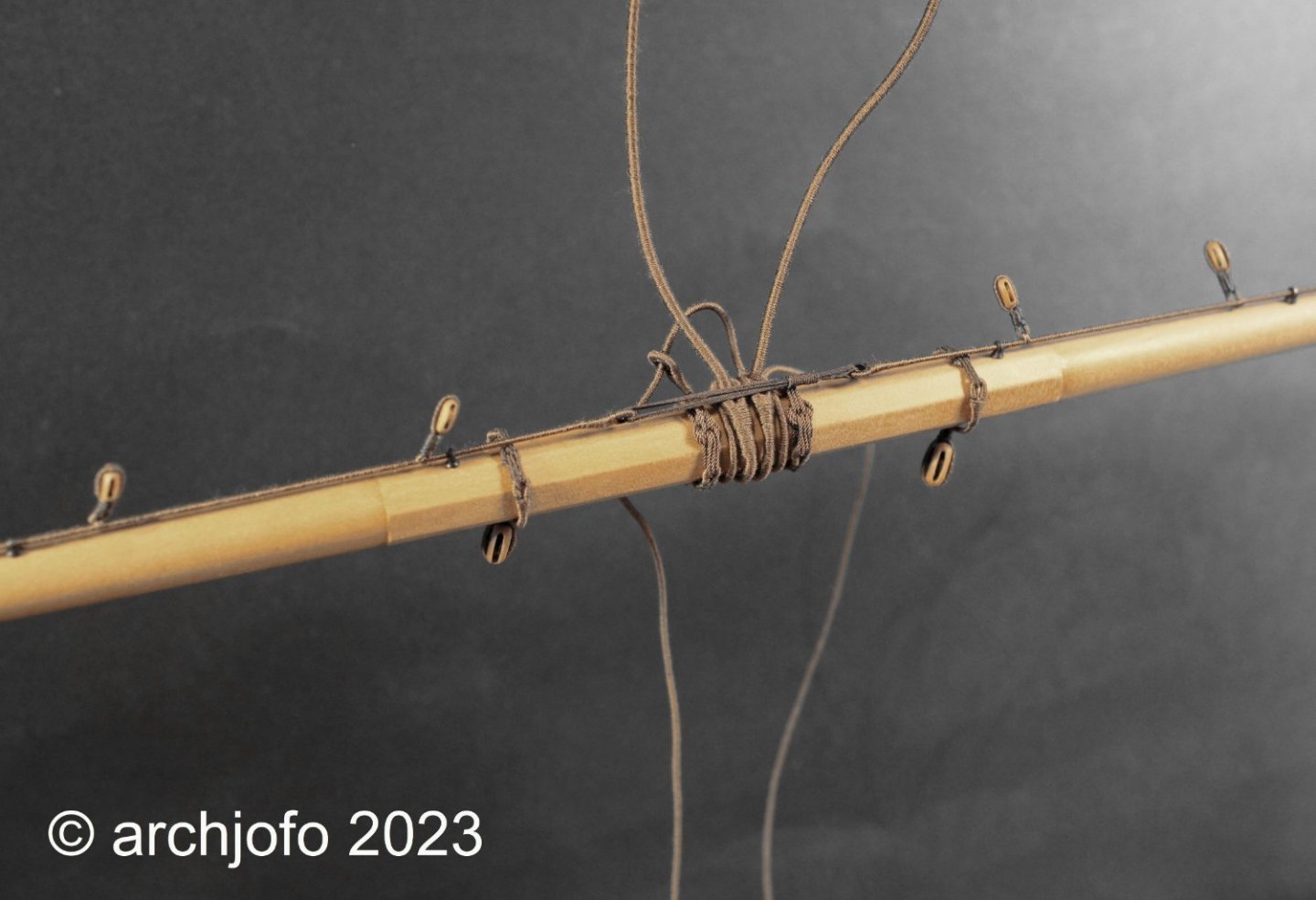
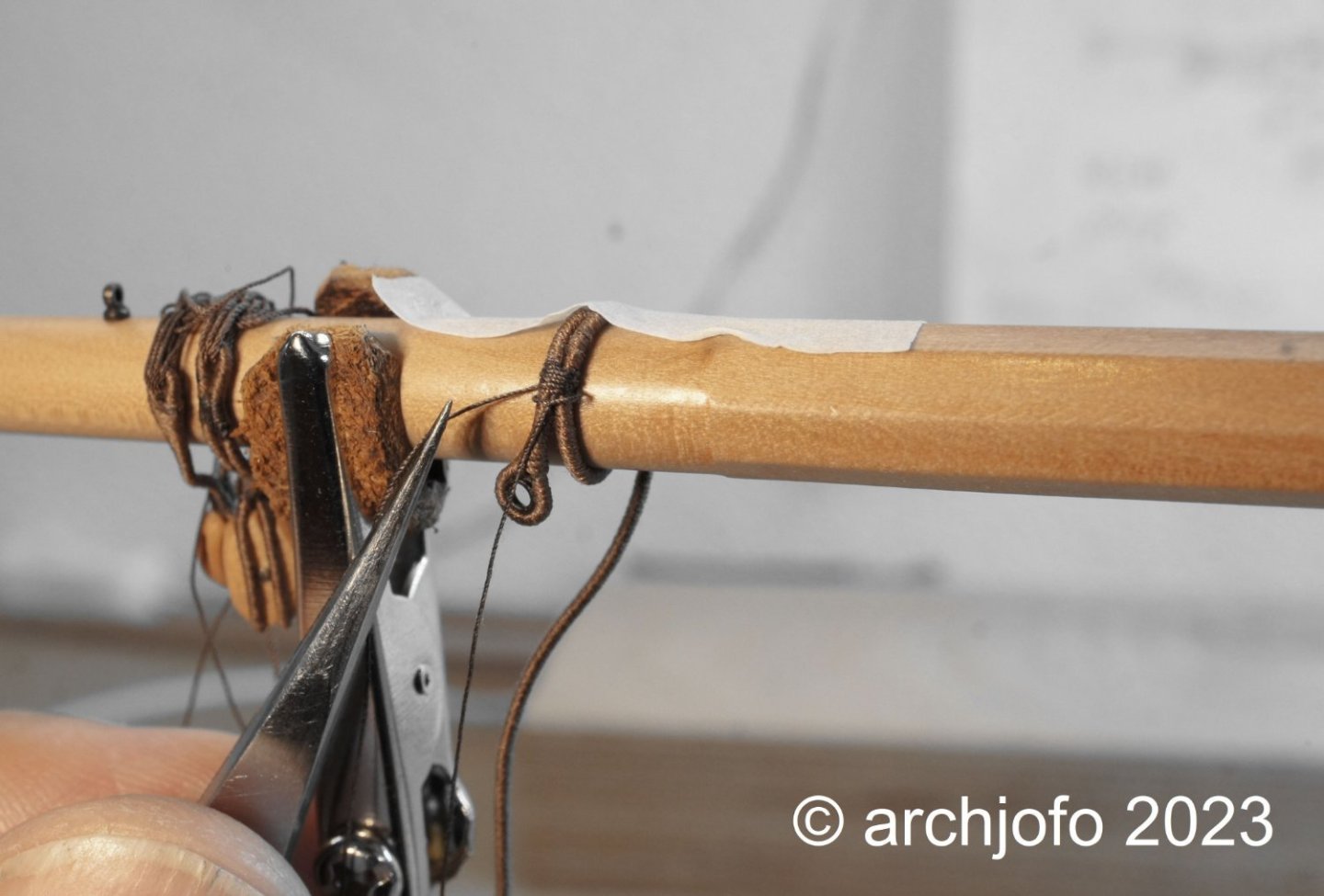
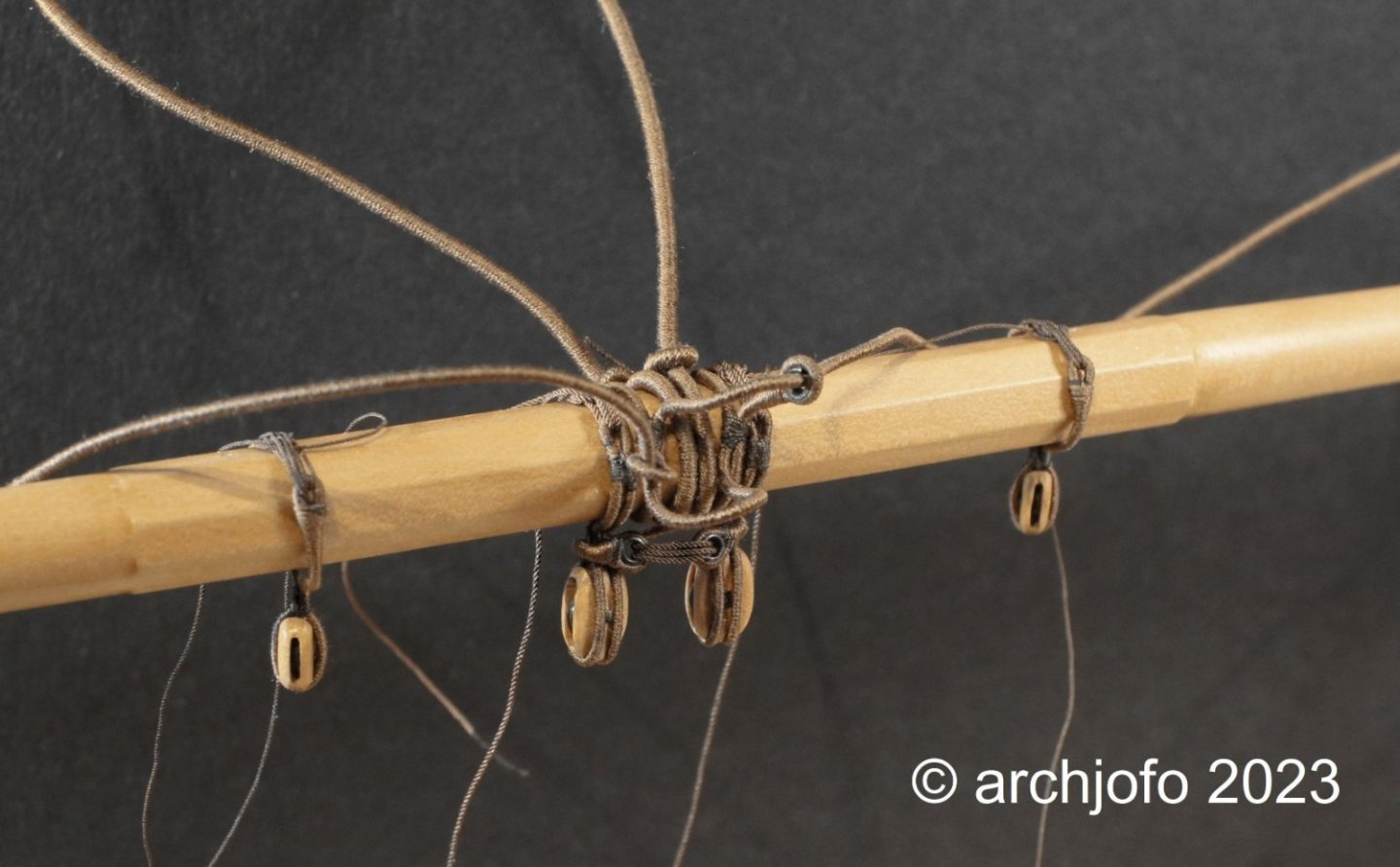
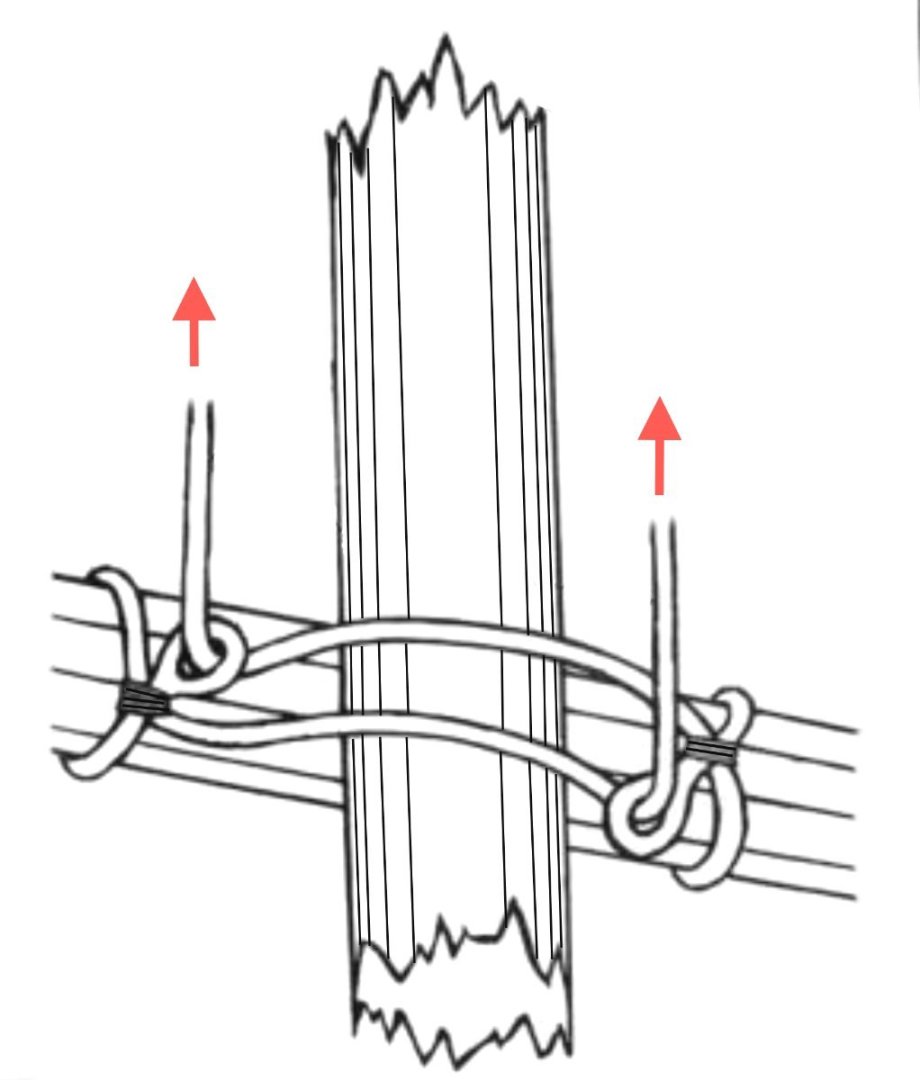
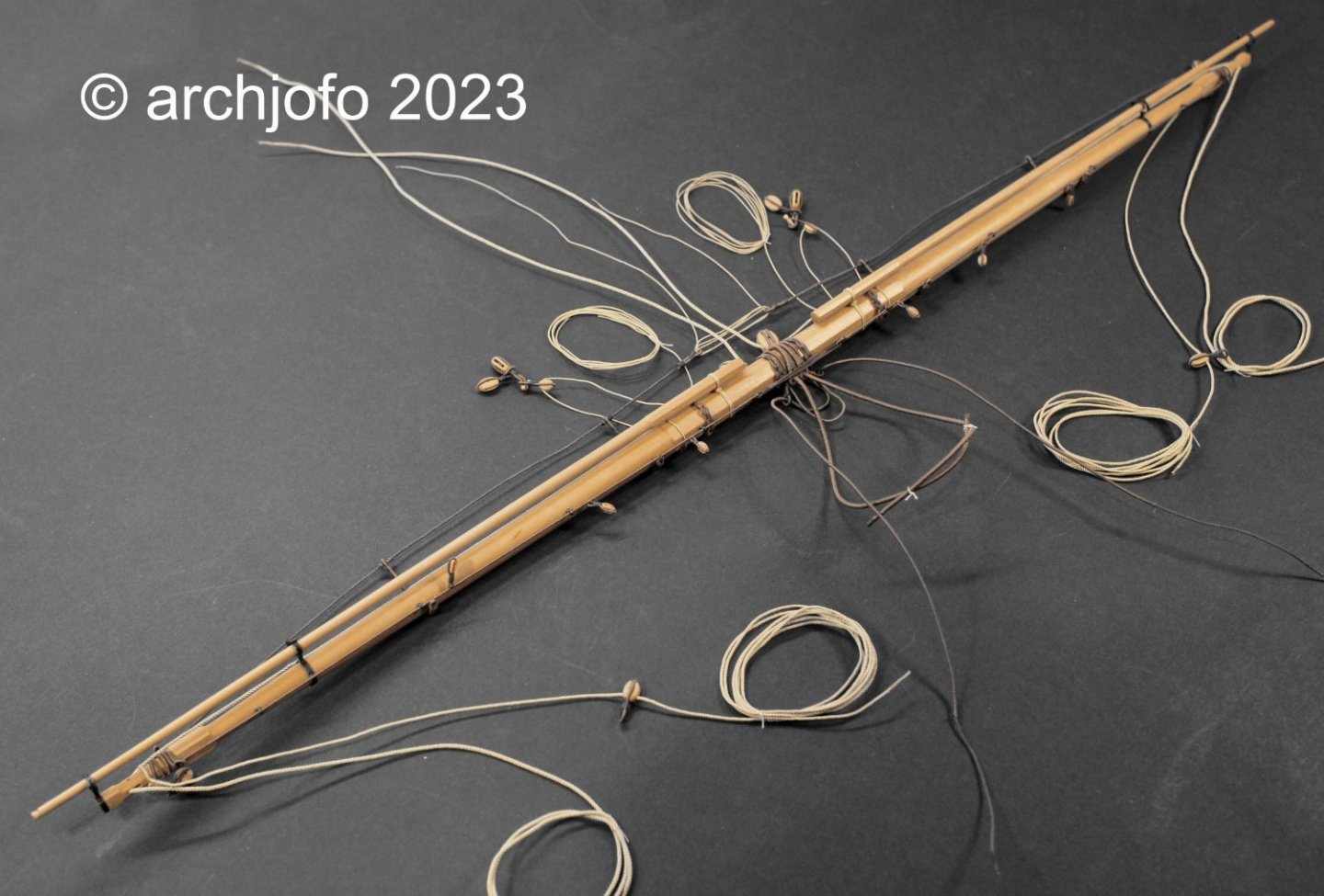
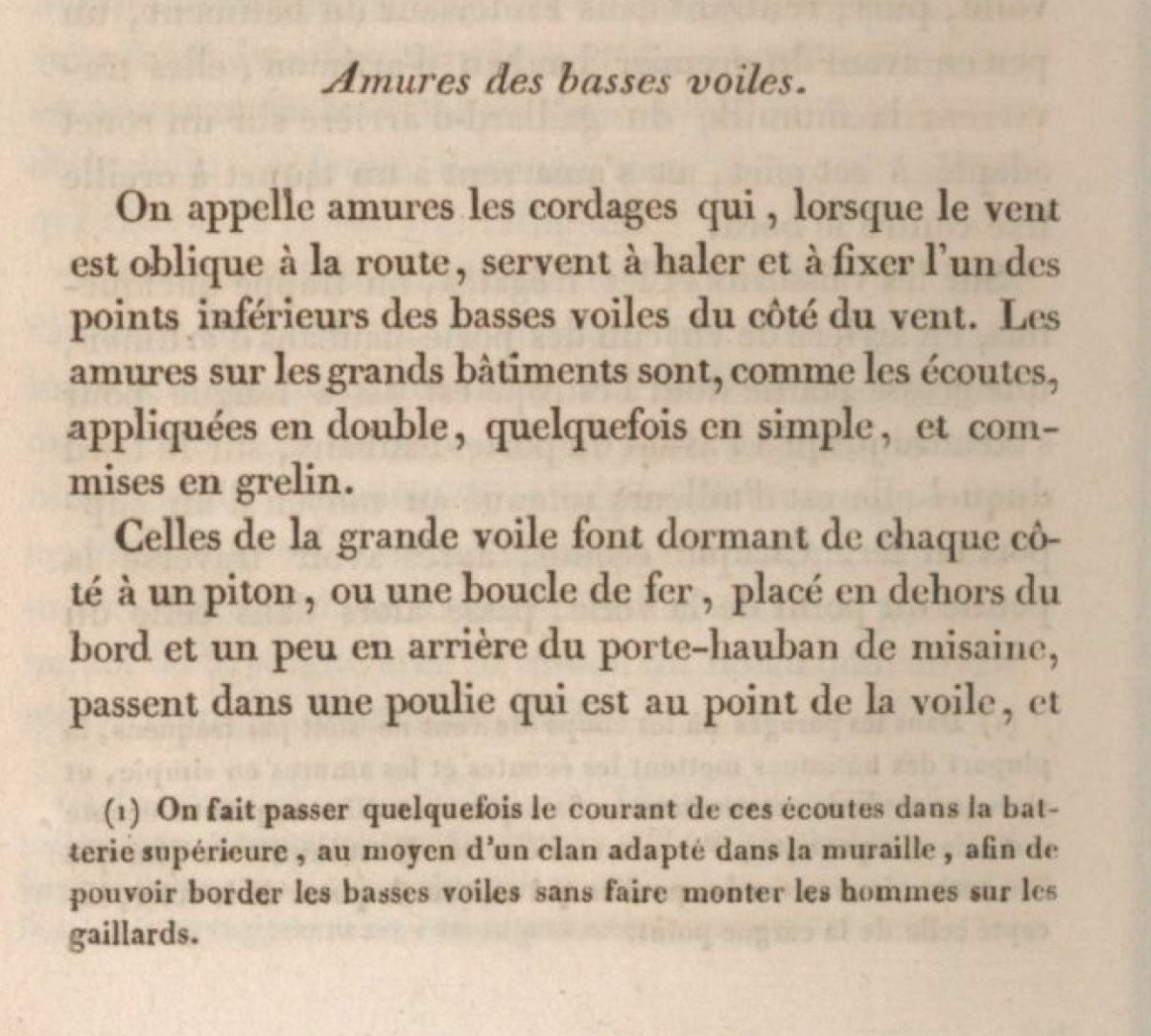
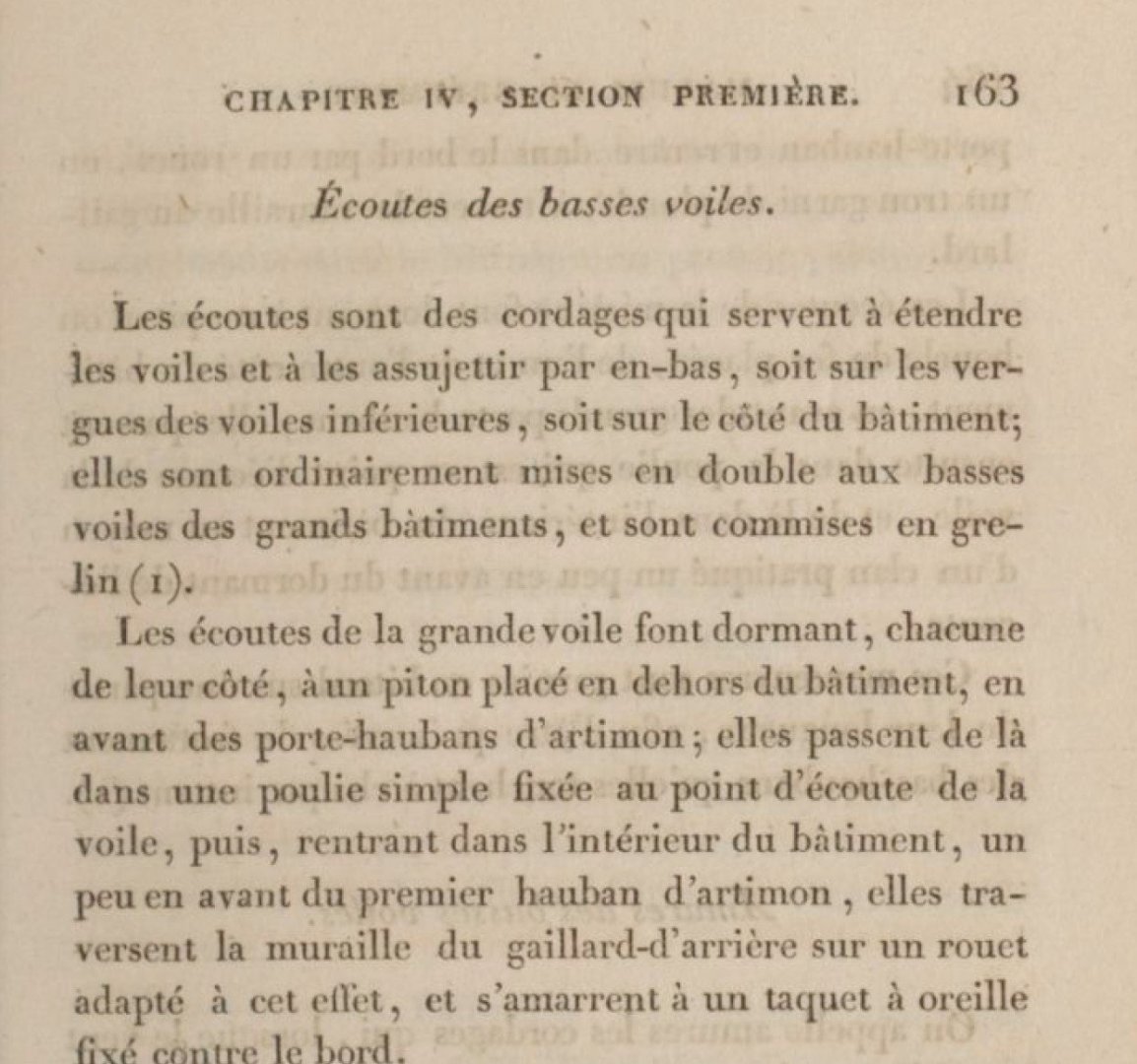
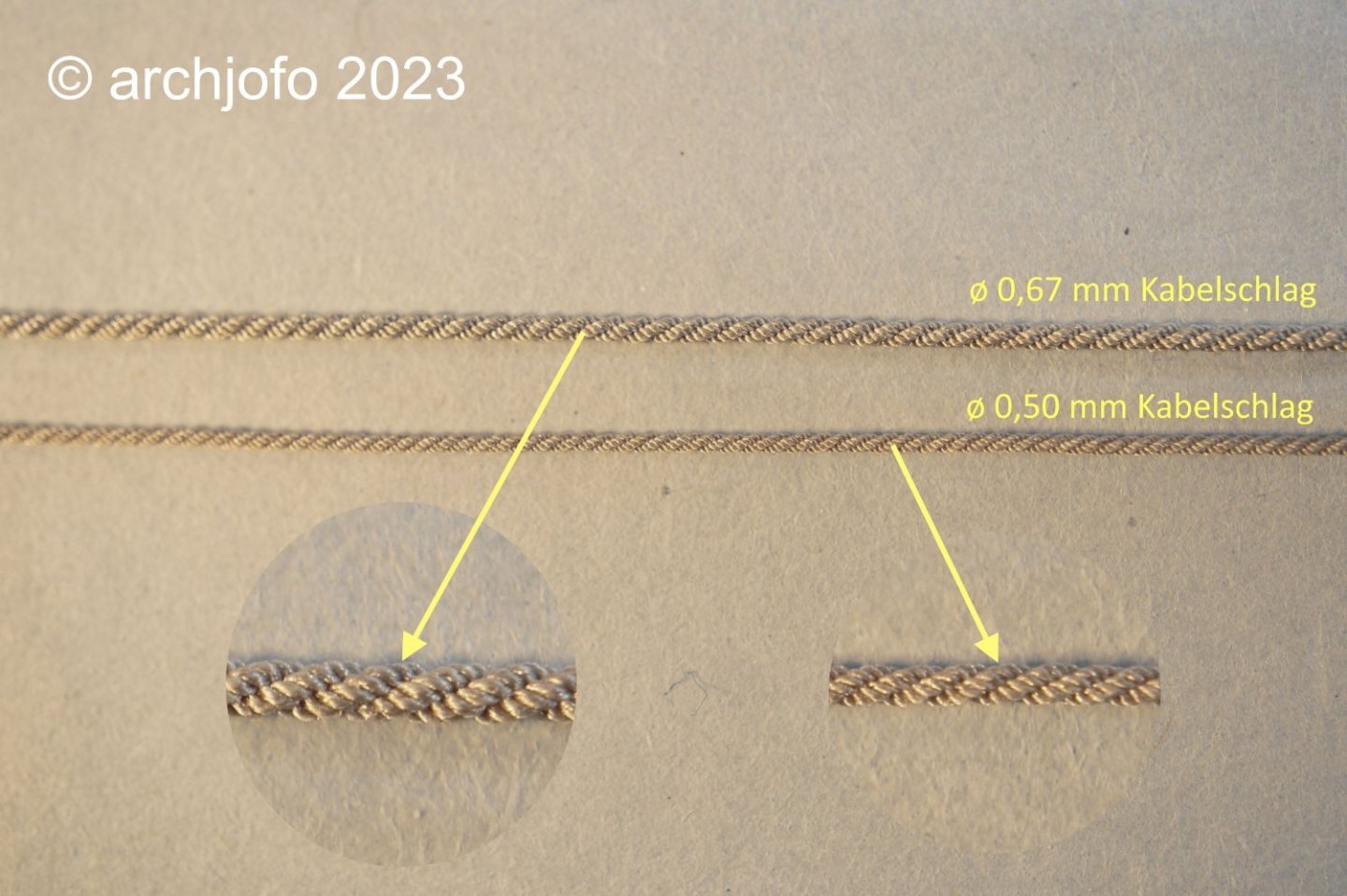
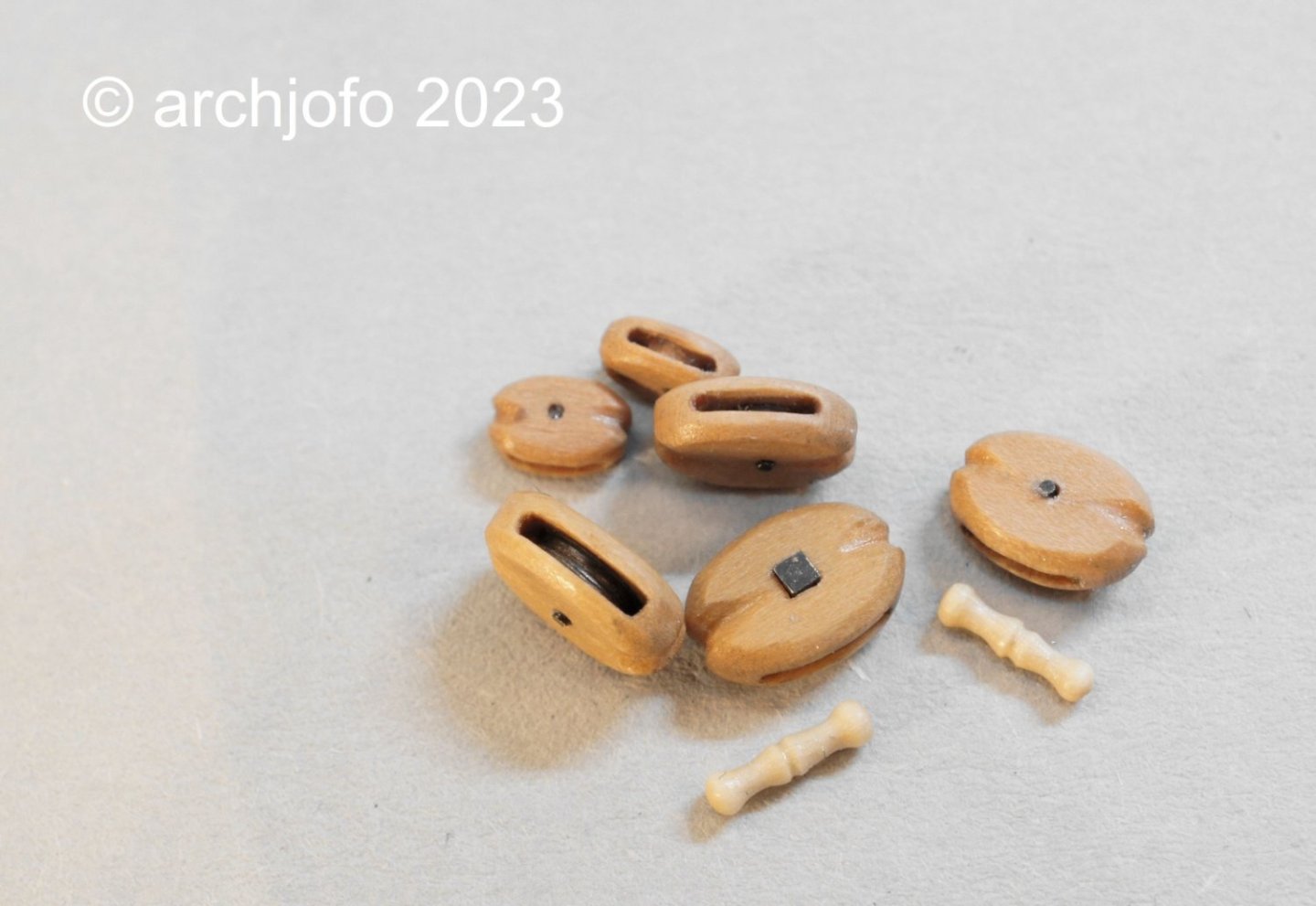
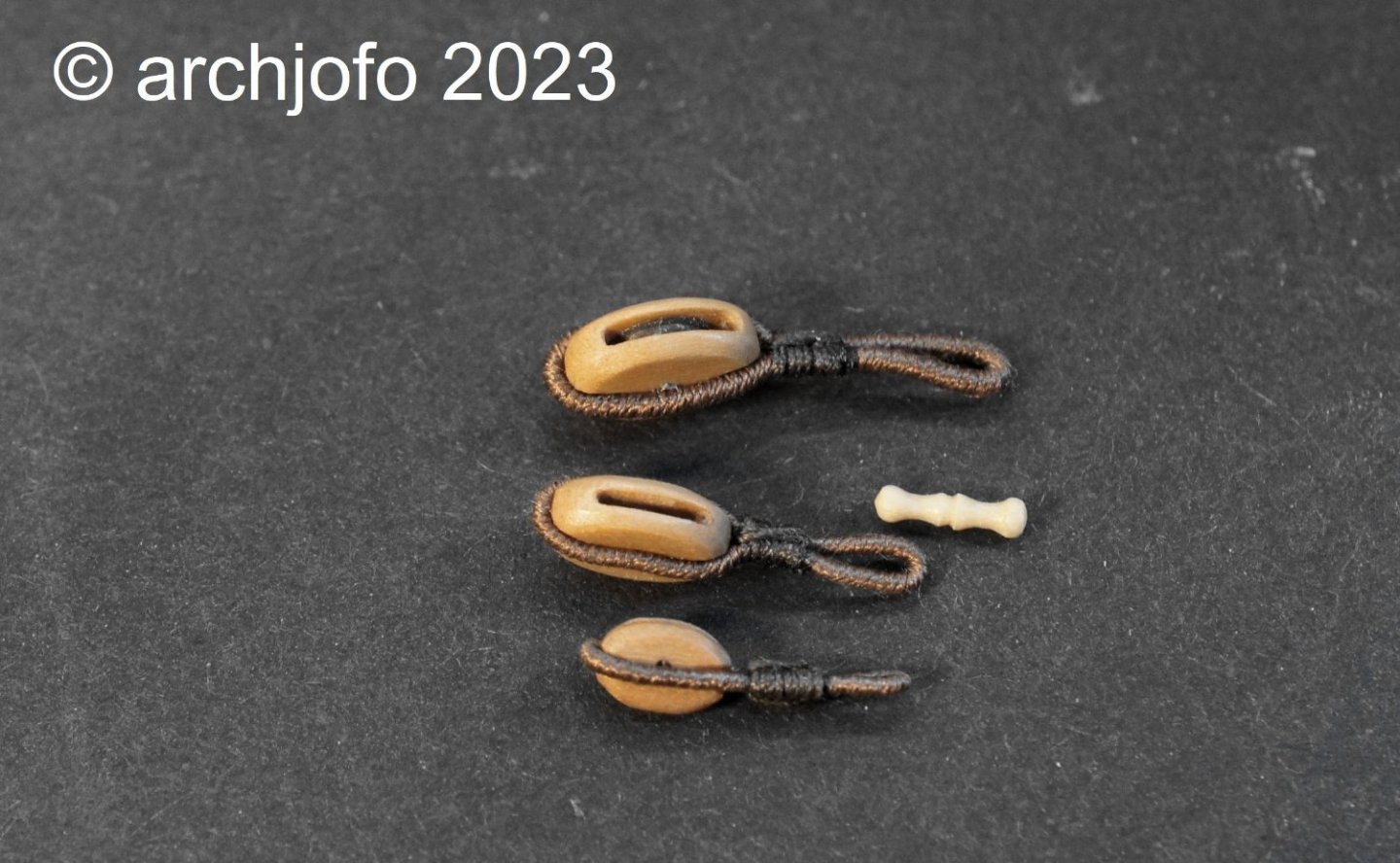
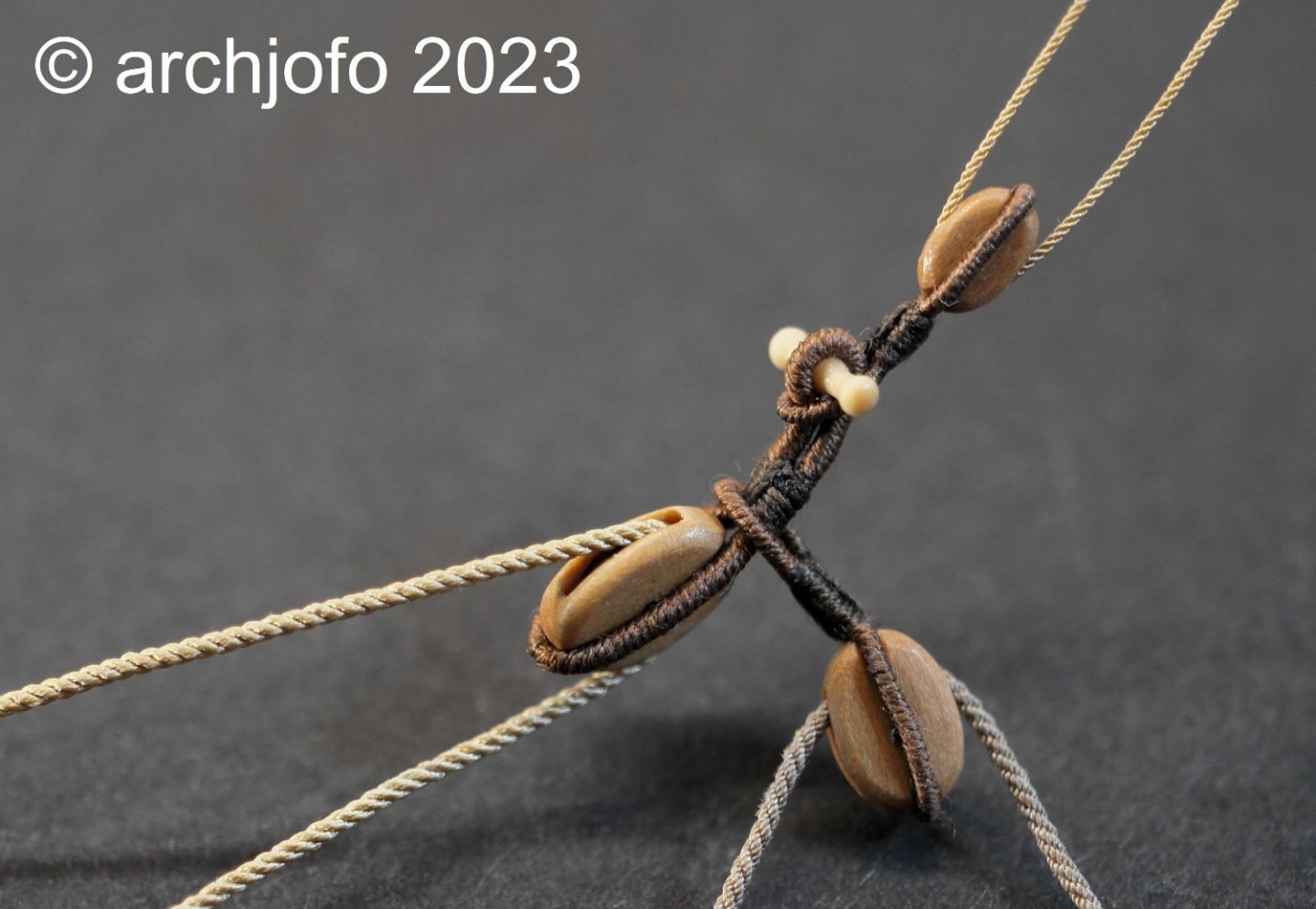
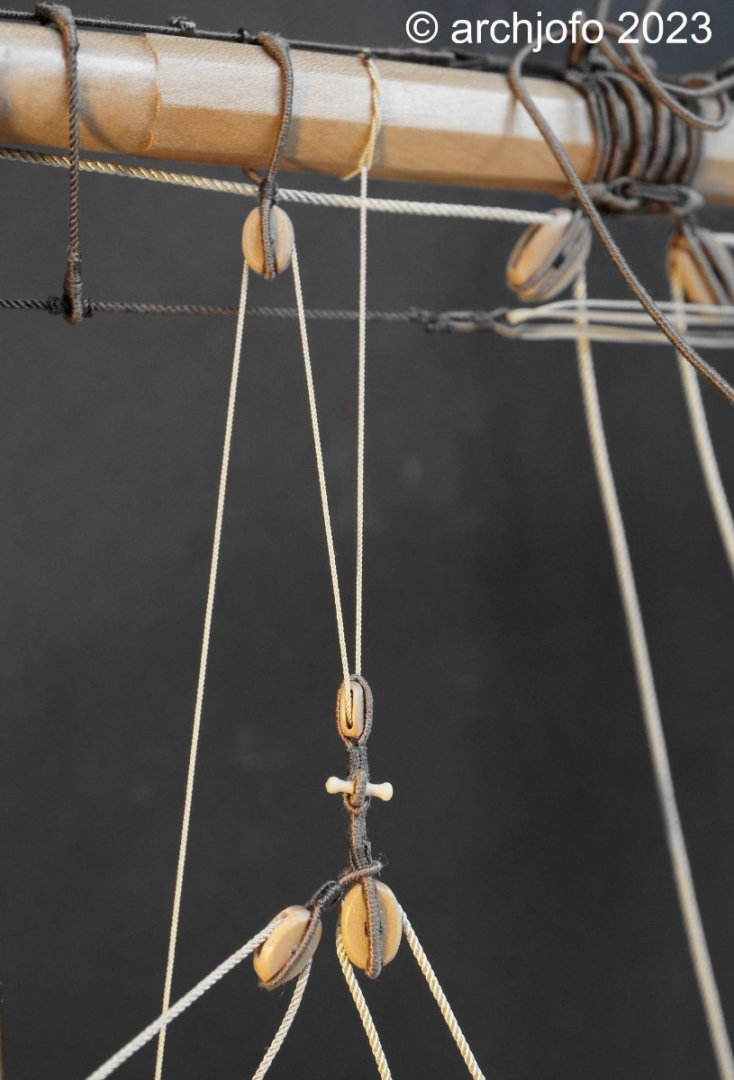
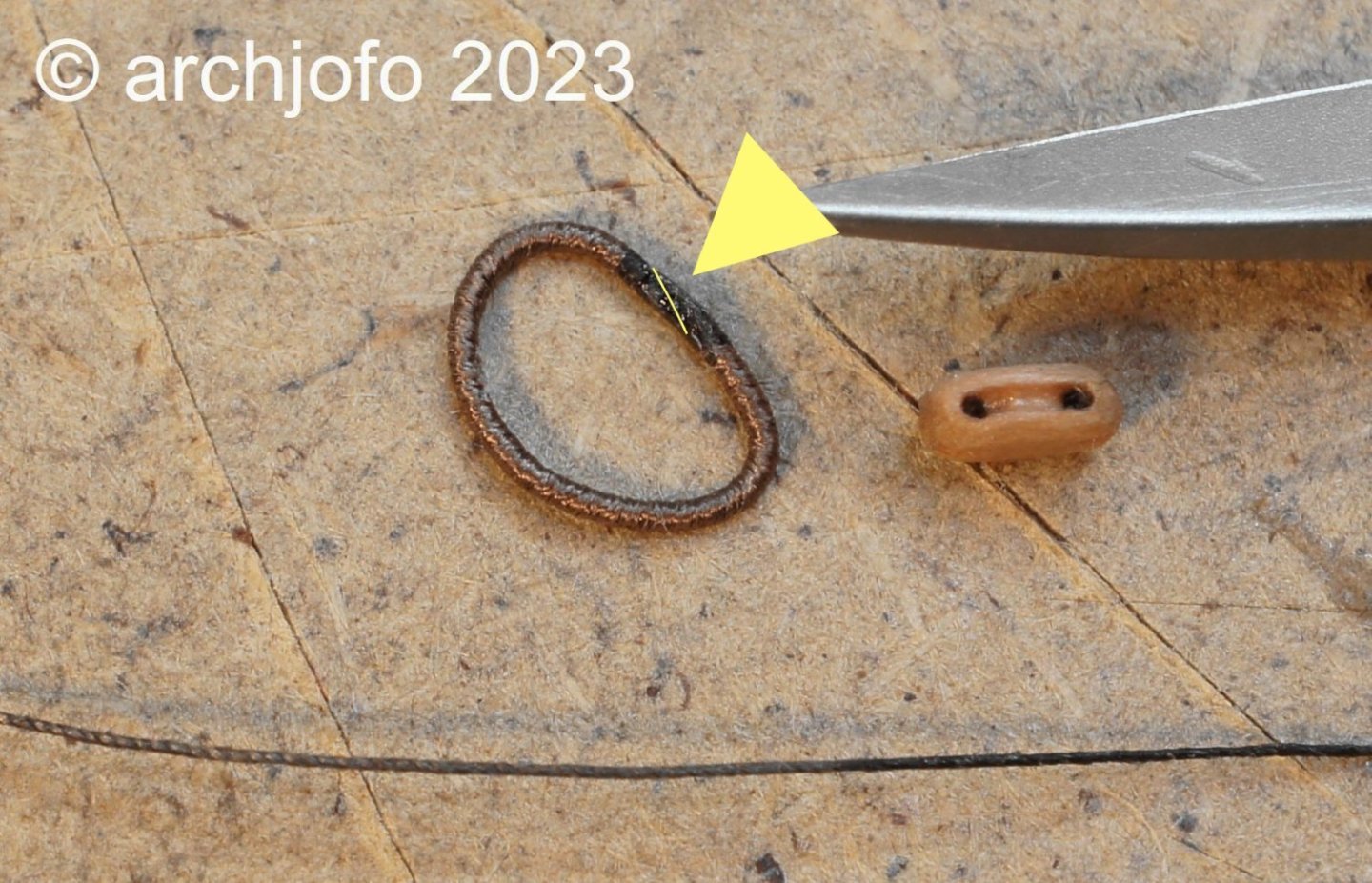
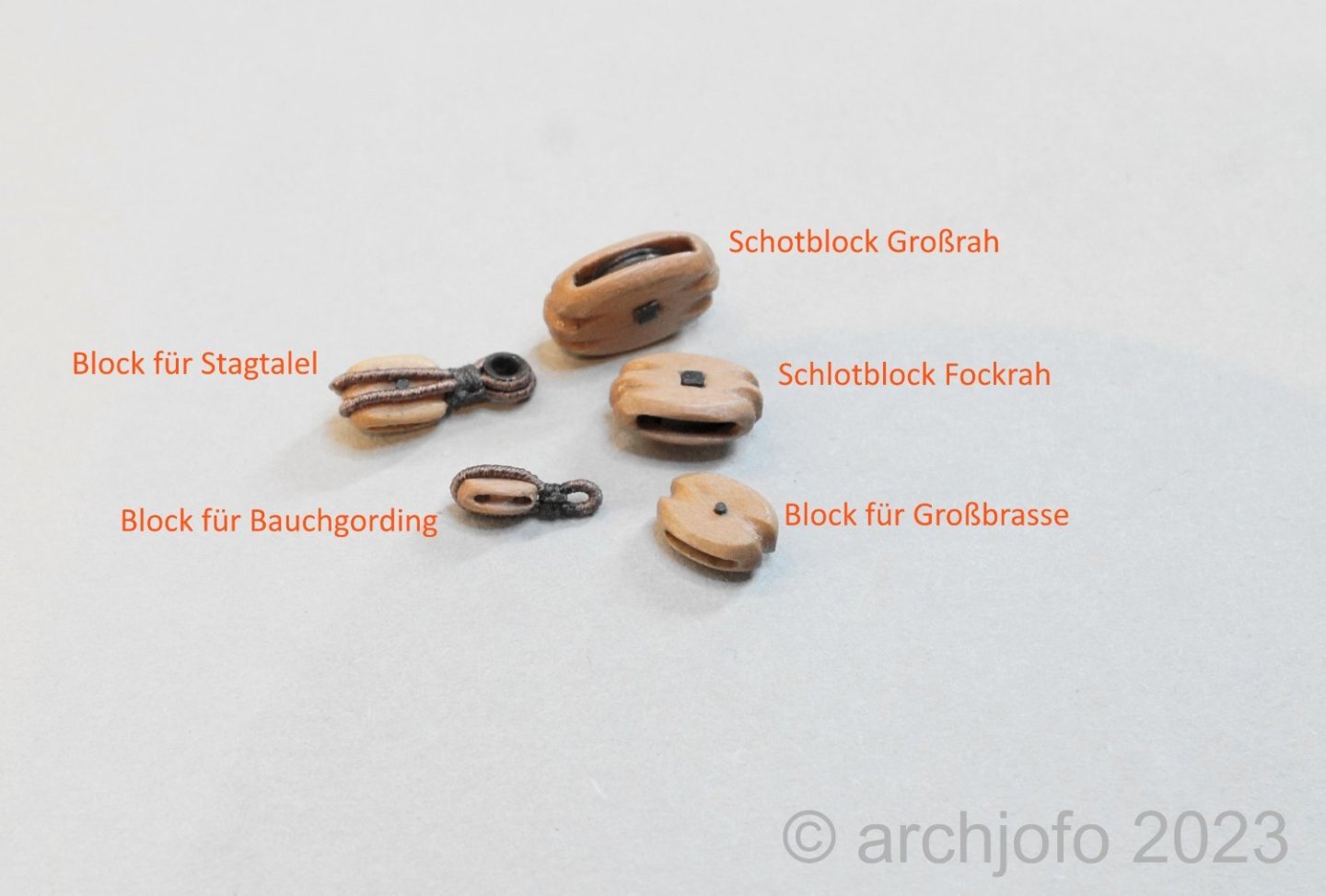
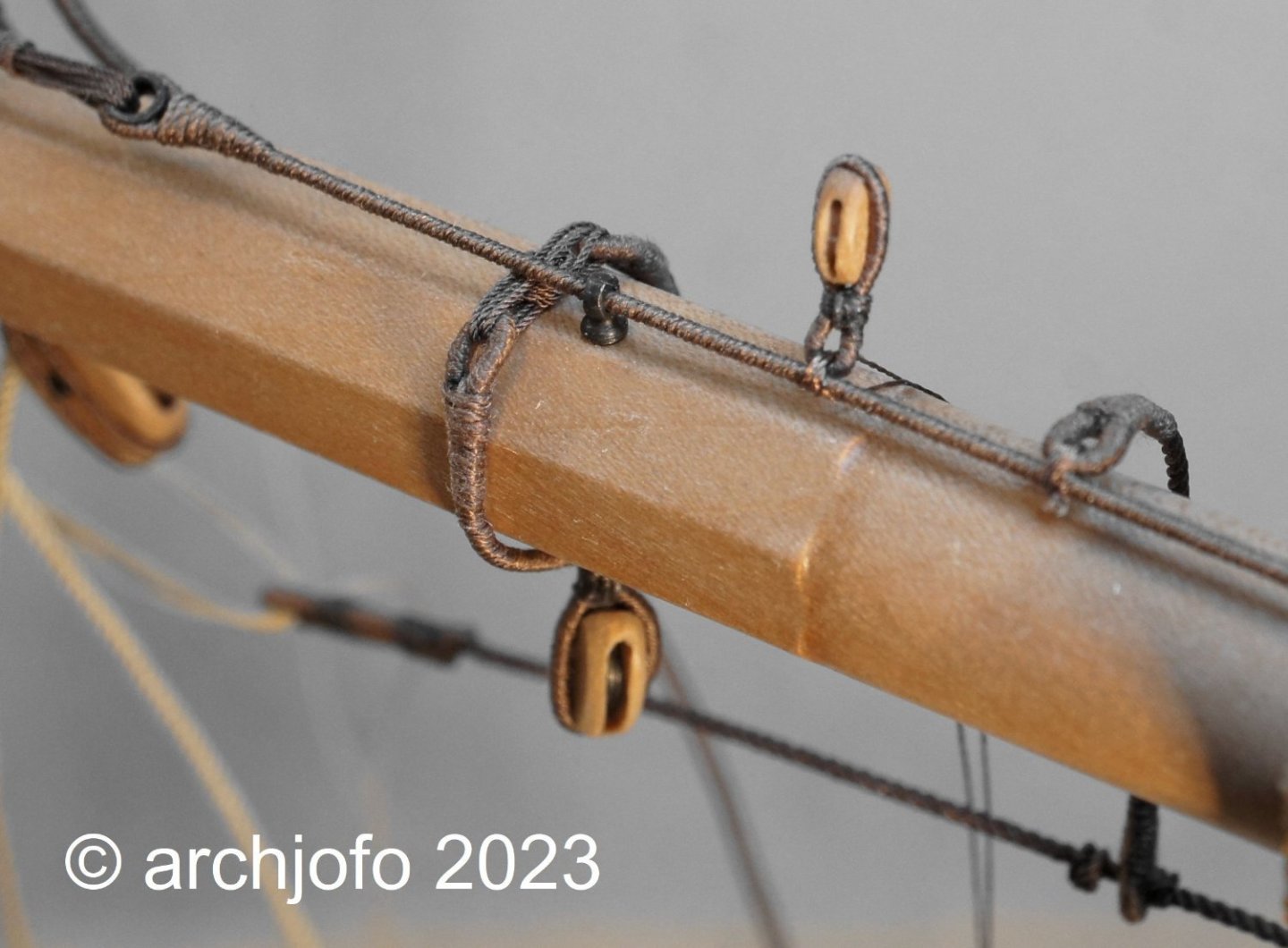
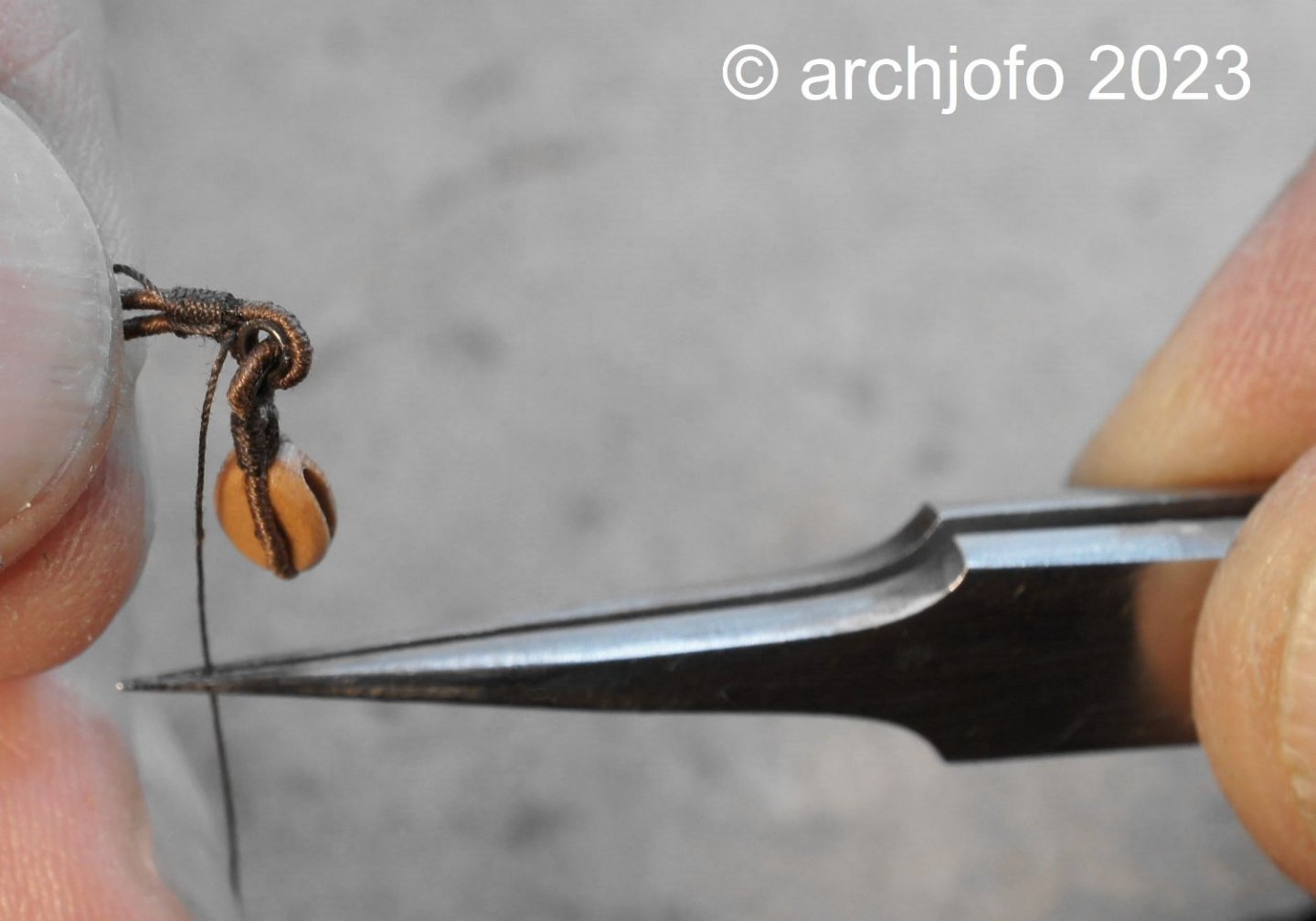
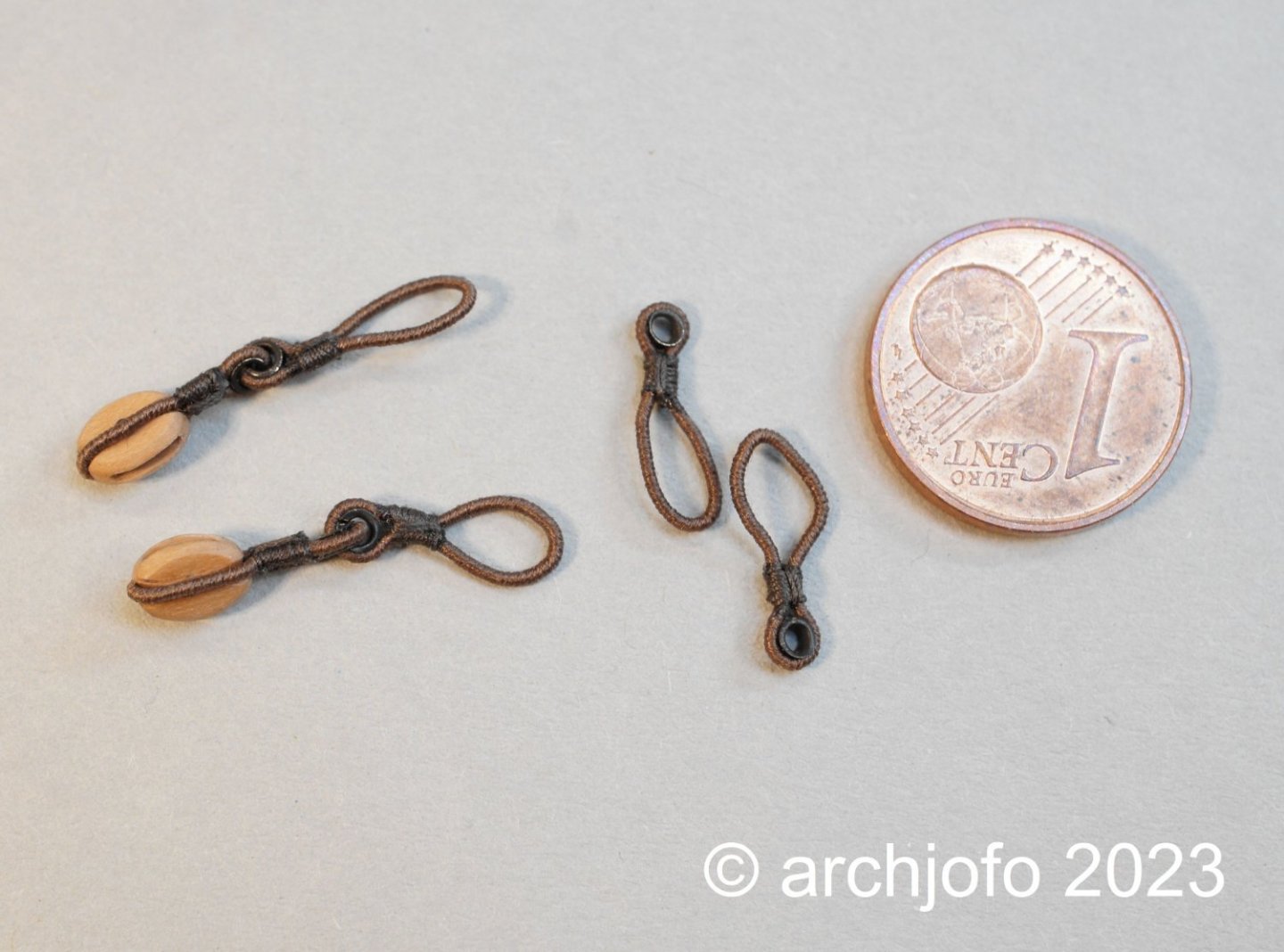

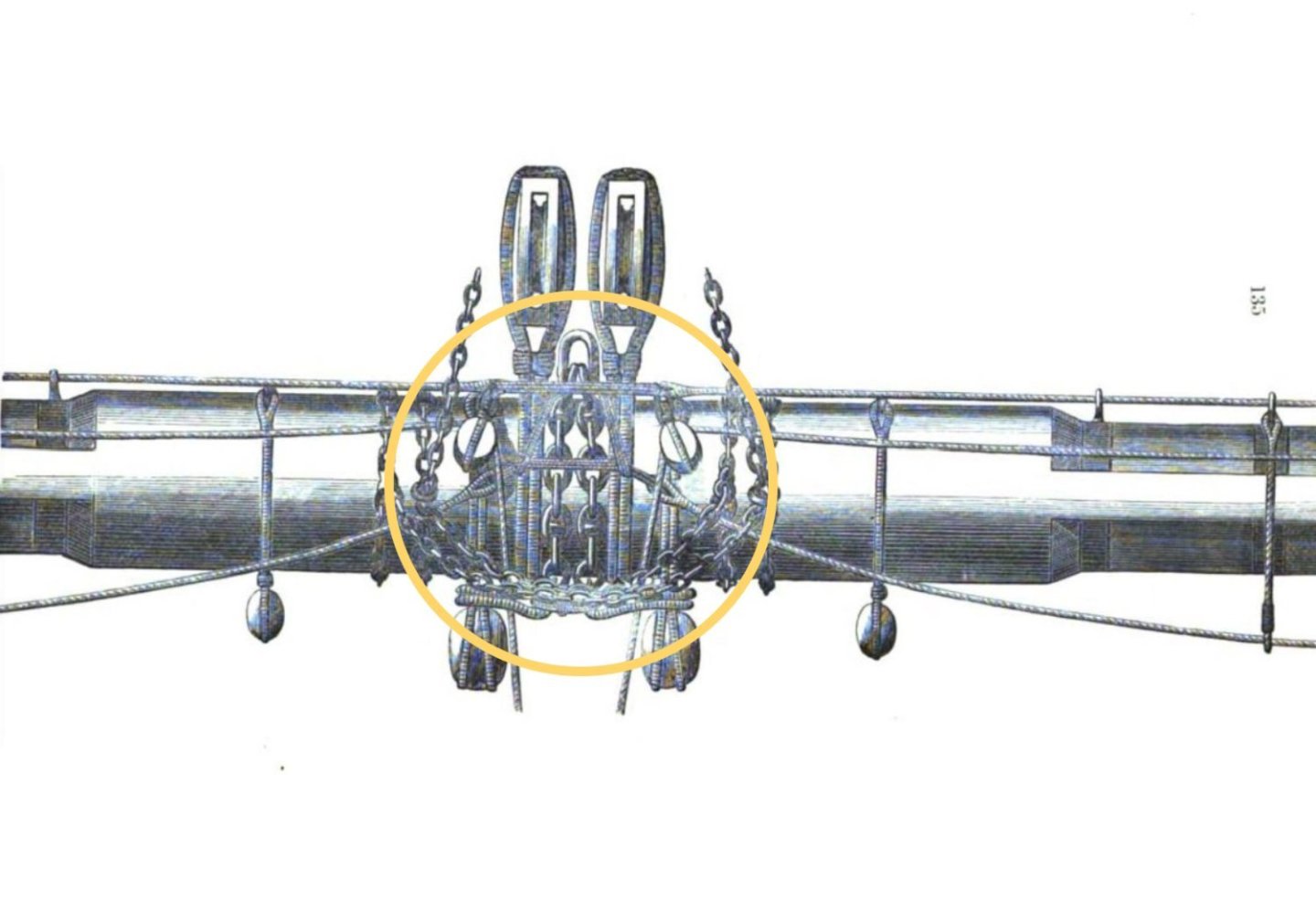
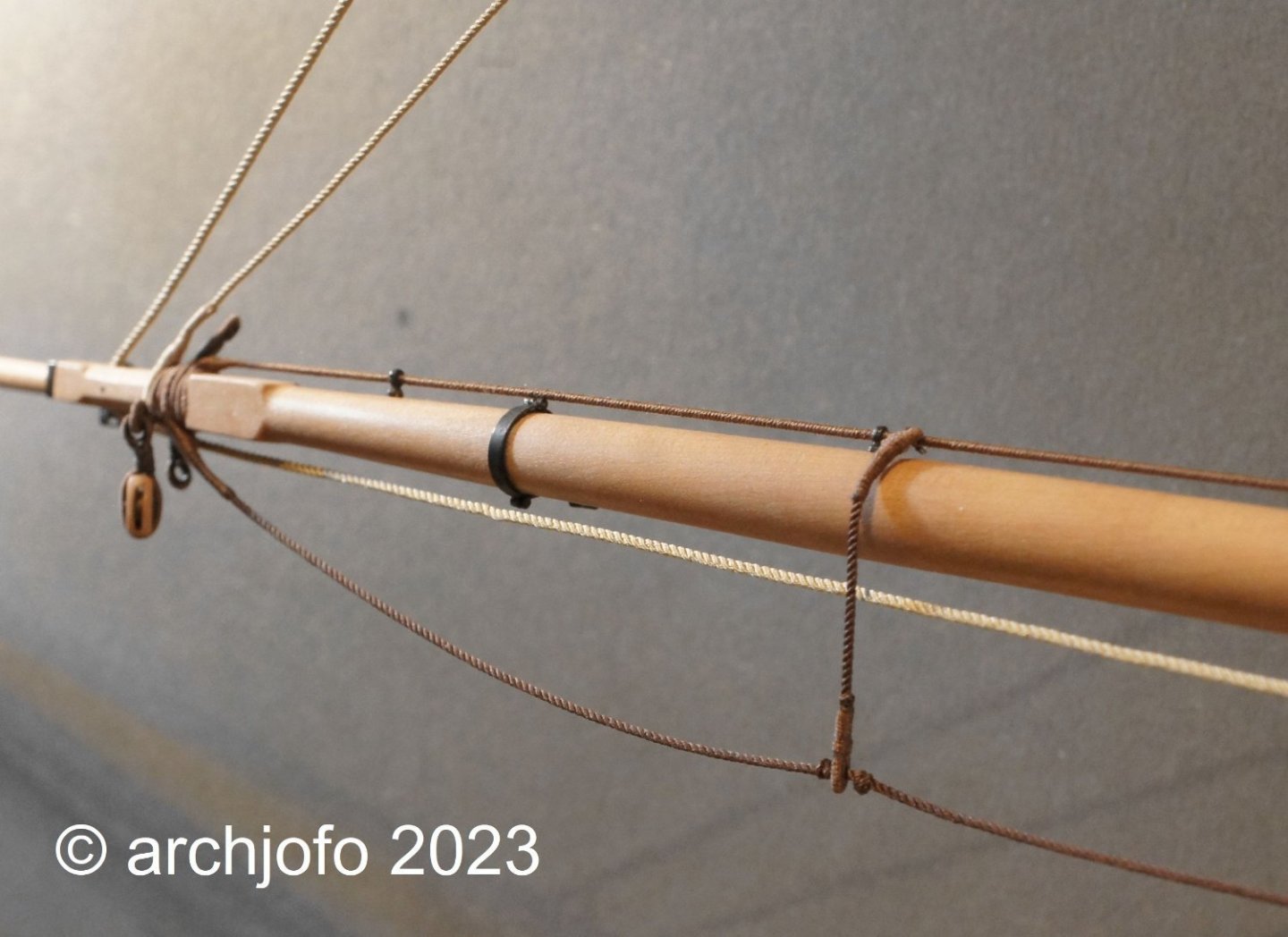
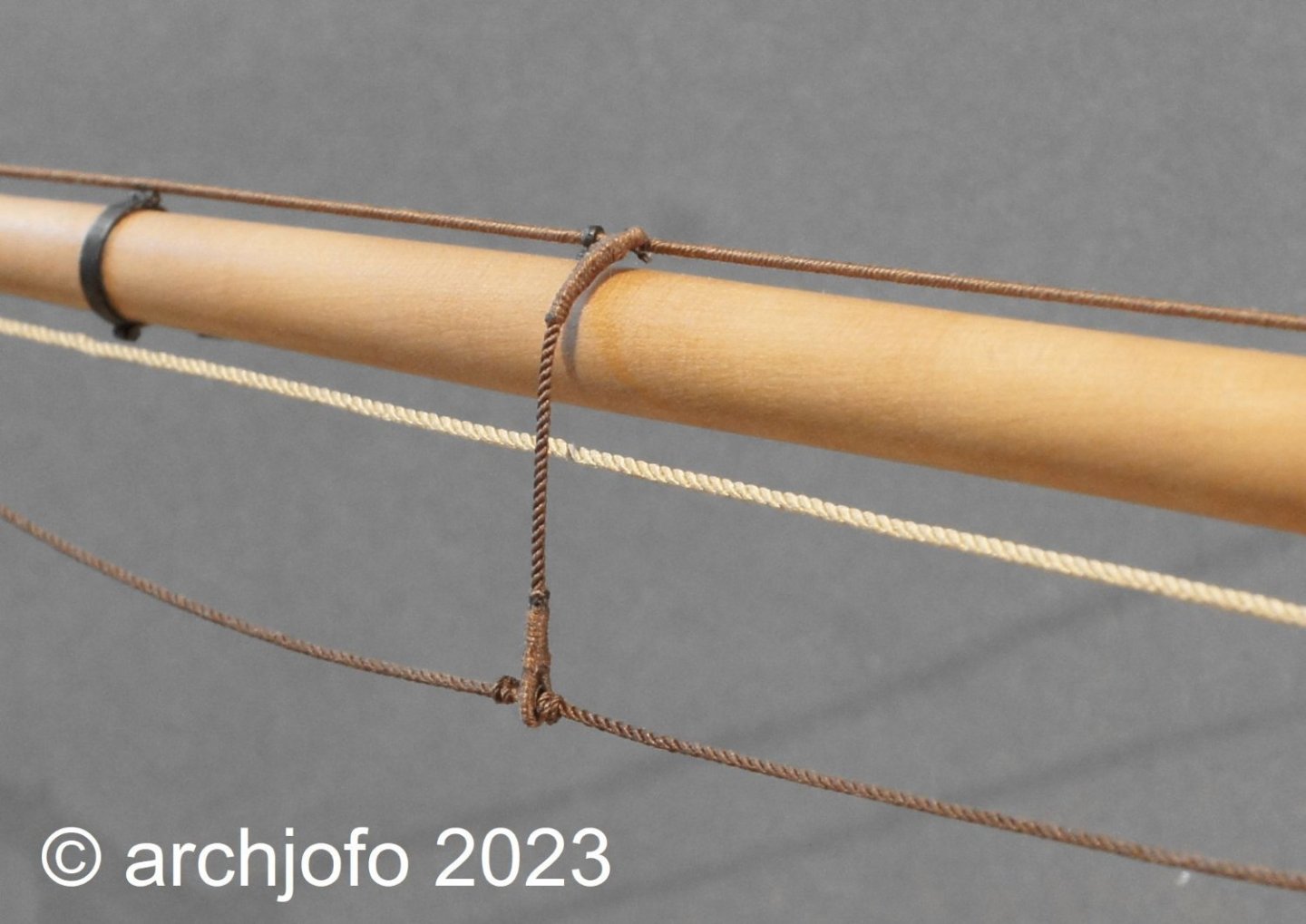
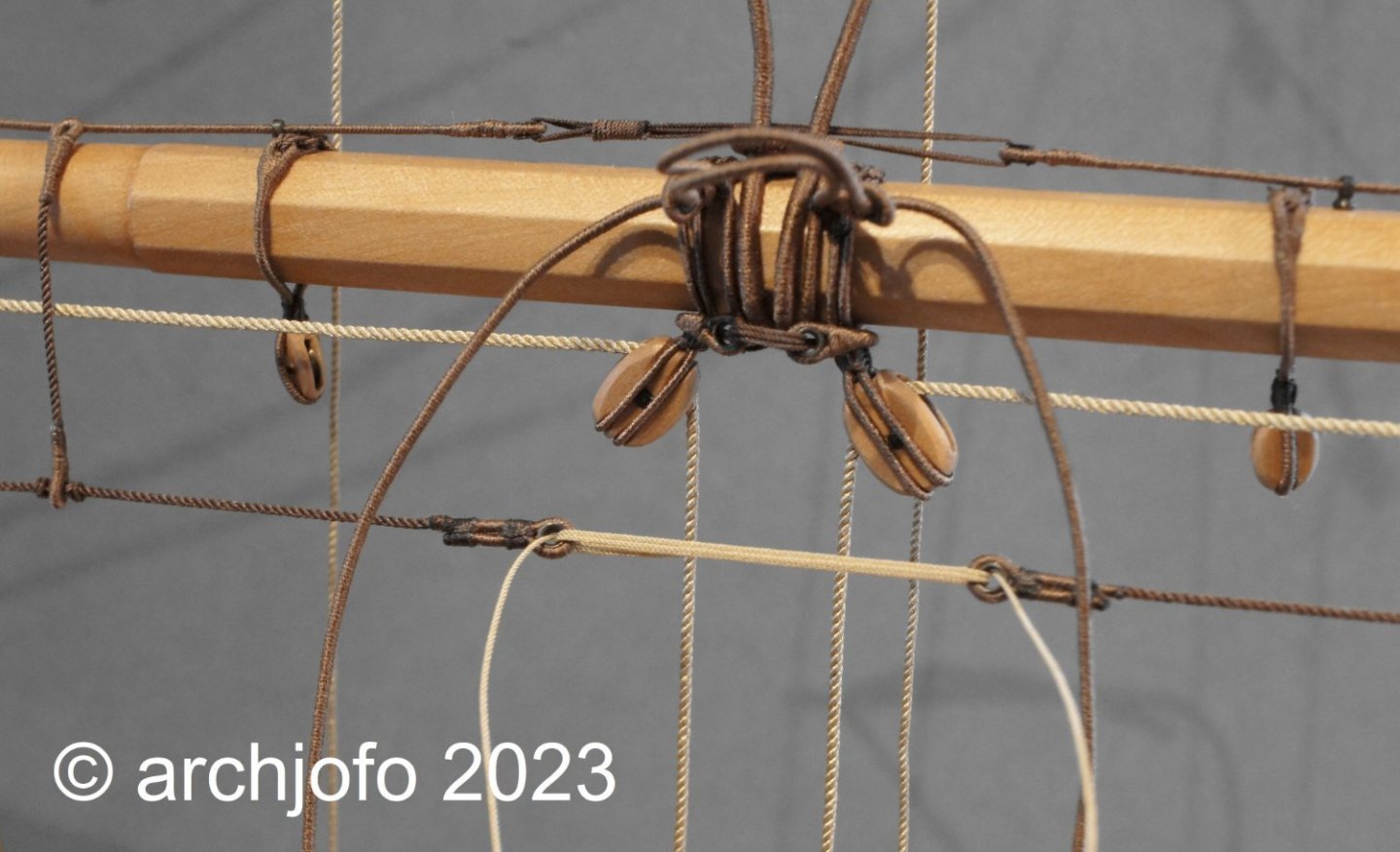
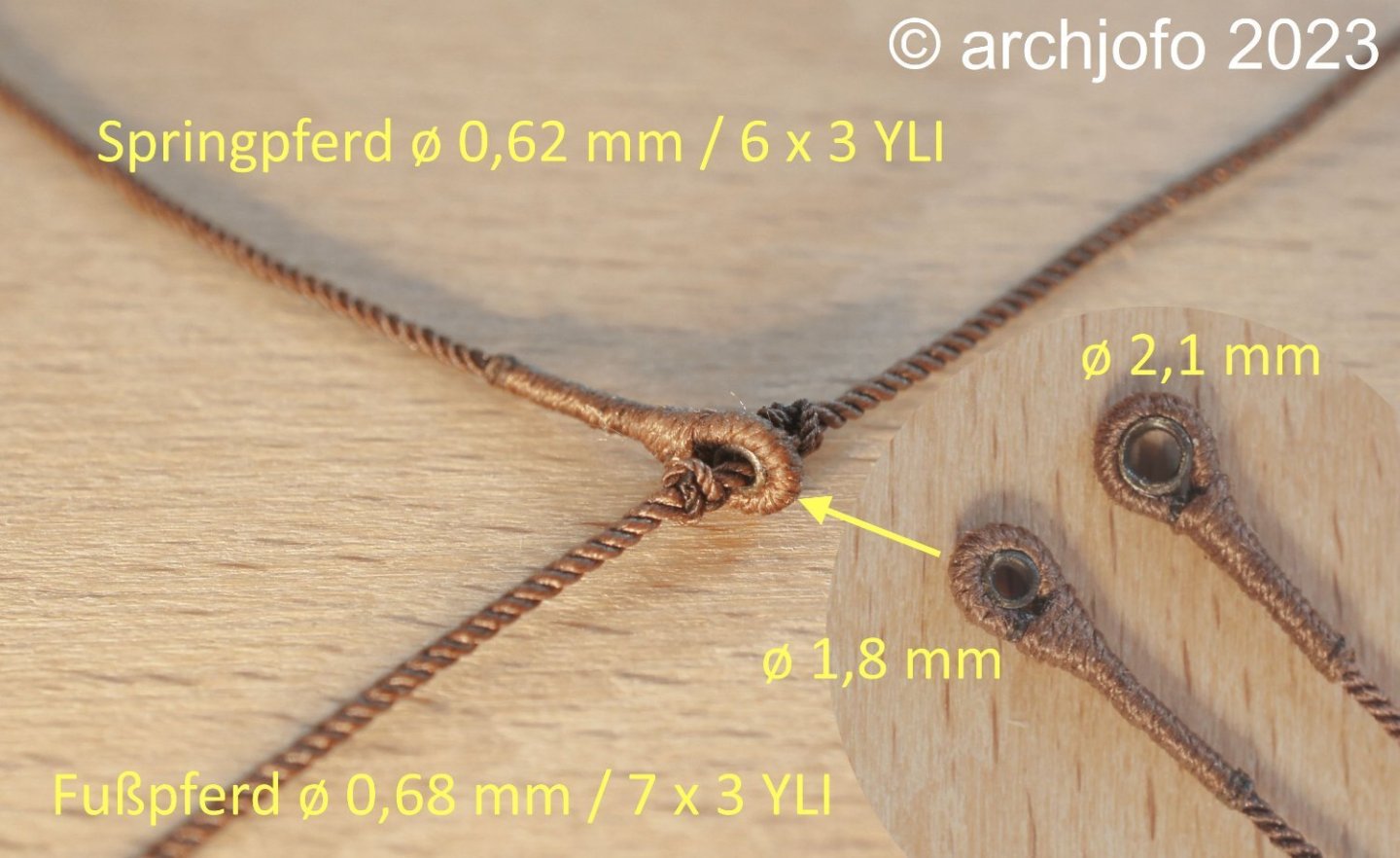
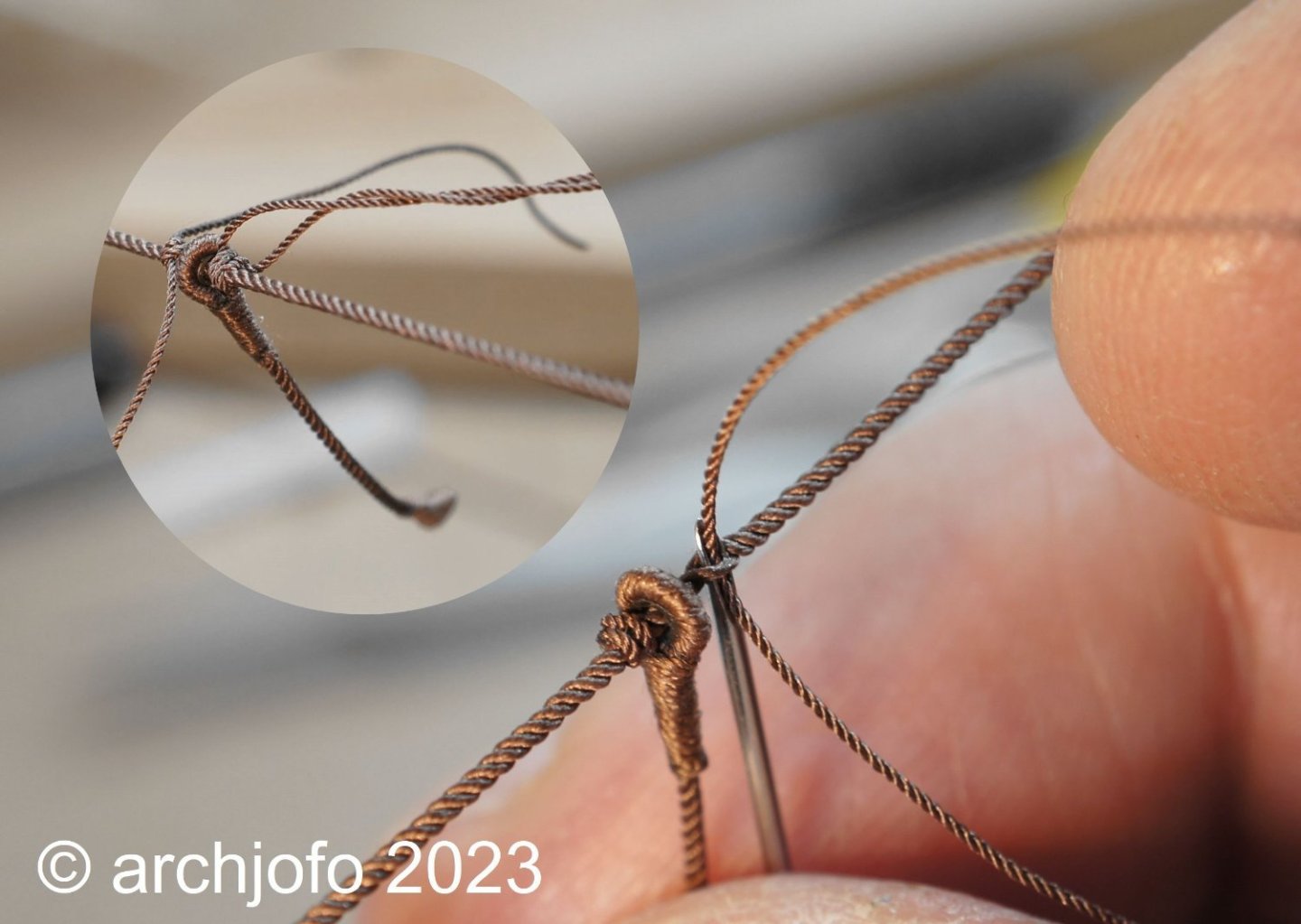

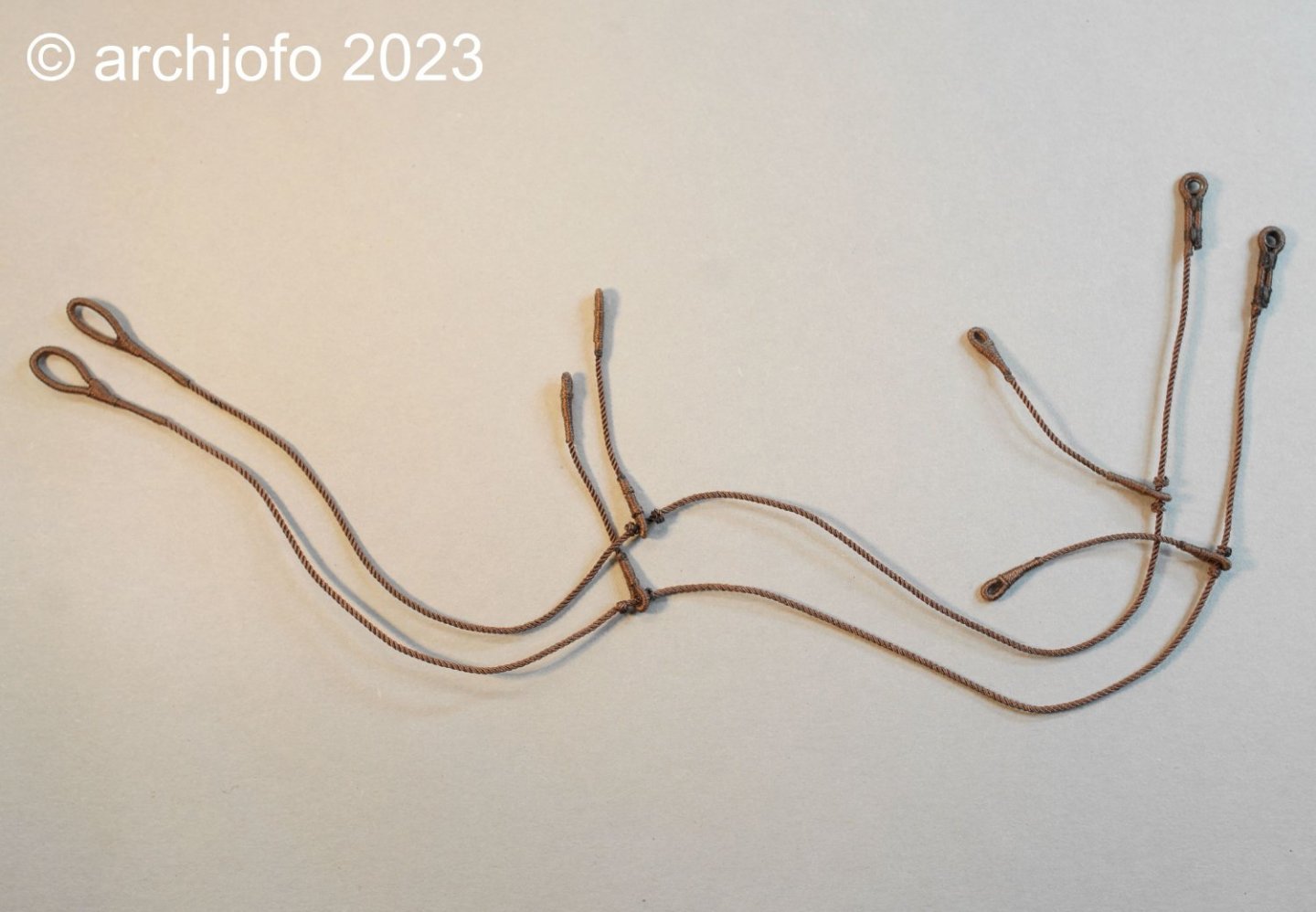
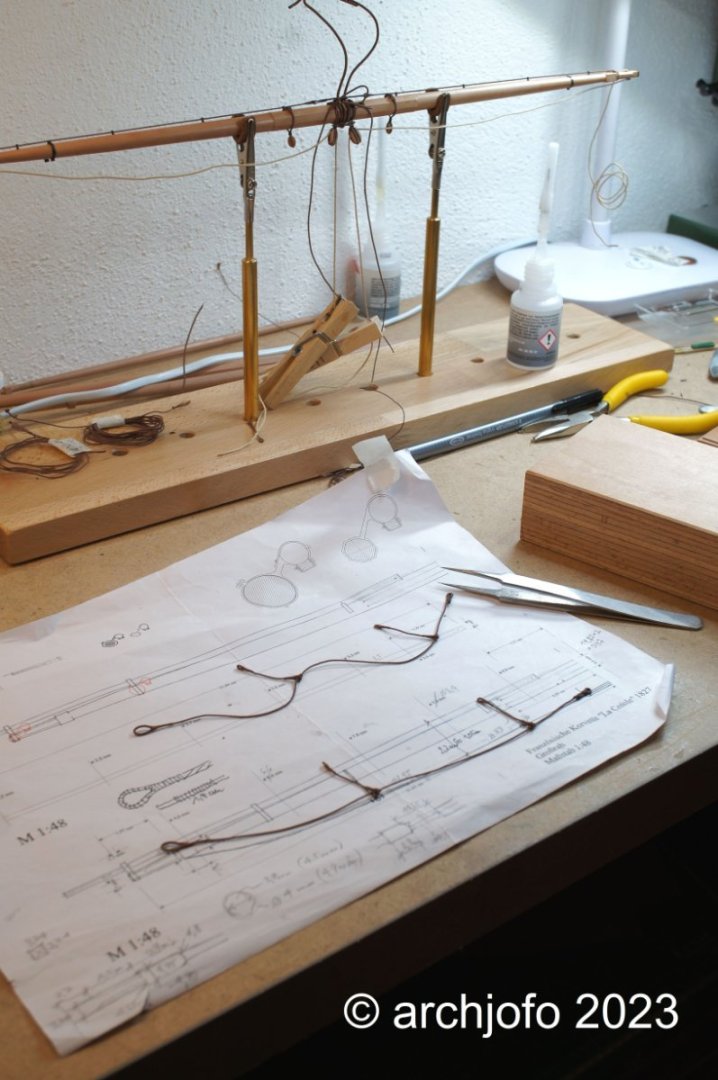
La Créole 1827 by archjofo - Scale 1/48 - French corvette
in - Build logs for subjects built 1801 - 1850
Posted
@Blacky
Hello,
Greg @dvm27 has already answered it so far, for which I'm grateful.
I look up a lot in the Ashley Book of Knots, which Bob @Bob Cleek also pointed out.
In some you have to simplify things in order to be able to implement them at model scale.
I only partially know the other sources mentioned by Bob. Thanks for that too.